Physical Address
304 North Cardinal St.
Dorchester Center, MA 02124
The purposes of the routine newborn assessment are to determine the infant’s gestational age, document normal growth and development for a given gestational age, uncover signs of birth-related trauma or congenital anomalies, and evaluate the overall health and condition of the infant. The assessment begins with the establishment of a historical database. Information may be obtained from antenatal, labor, delivery, and postpartum records and a brief interview with the parents. The aim of this data gathering is to assess the fetal and neonatal responses to pregnancy, labor, and delivery; to estimate the risk for hereditary or congenital diseases; and to identify the potential for future difficulties by reviewing the family’s social history and observing maternal/infant interactions. This background is recorded in the infant’s medical record and serves as a guide to the subsequent physical examination ( Box 2.1 ).
Maternal age
Maternal medical history
Obstetric history
Number of previous pregnancies
Number of term/preterm deliveries
Outcomes of previous pregnancies
Estimations of gestational age
Antenatal ultrasound
Advanced imaging (fetal echocardiograms, fetal MRI)
Fetal surveillance results (if available)
Complications of pregnancy
Adequacy of antenatal care
Maternal lab work: blood type, serologies, genetic testing
Date and time of delivery
Duration of labor
Time of the rupture of membranes
Complications or abnormalities of labor
Method of delivery or type of anesthesia
Placental weight and morphologic condition
Birth weight
Need for resuscitation and Apgar scores
Maternal postpartum complications
Newborn vital sign records
Newborn labs (commonly bilirubin and glucose)
Nursing documentation of the activity and condition of the infant
On admission to the nursery
Since admission to the nursery
Abnormal physical findings noted by the nursing staff
Feeding, voiding, and stool history
Observations of maternal/infant interactions
Parental perceptions of:
Pregnancy
Labor
Delivery
History of parental and family illnesses
Health status and growth and development of siblings and other family members
Degree of education, preparation, and planning for newborn care
Available social support systems
Medical follow-up plans
Whenever possible, it is preferable that the newborn be examined in the presence of one or both parents to reassure them regarding normal variations and to discuss any abnormal findings. The baby should remain at least partially clothed through as much of the examination as possible, although a complete and thorough examination is imperative. The examiner’s hands should be warmed to minimize the chance that the infant will become uncomfortable because of heat loss.
Observation must be done before the quiet infant is disturbed by the examination. By visual inspection the clinician can assess skin and facies; general tone and symmetry of movement; respiratory rate, retractions, color, and abdominal contour. Auscultation of the heart and lungs should be done before more stressful portions of the examination, which are likely to make the infant fussy. Auscultation of the cranium and over the liver (the most common sites for arteriovenous malformations [AVMs]) is also part of a complete newborn exam and presence of a bruit will alert the examiner that further investigation is warranted ( Fig. 2.1 ). Checking for femoral pulses is a quick screen for coarctation of the aorta. Bounding pulses may indicate a shunt, such as AVM or patent ductus arteriosus (PDA). Allowing the infant to suck on a gloved finger can help quiet the infant and permit assessment of sucking strength and palate integrity. Lifting the infant under the arms and gently rocking him or her (such that the head swings toward and away from the examiner) is usually calming. This maneuver also induces a reflexive opening of the eyes, which assists the ophthalmologic examination. Sucking also induces eye opening. Such maneuvers may allow the examiner to better see a red reflex and determine that the patient does not have a congenital cataract or an intraorbital mass (see Chapter 21 ) requiring prompt intervention.
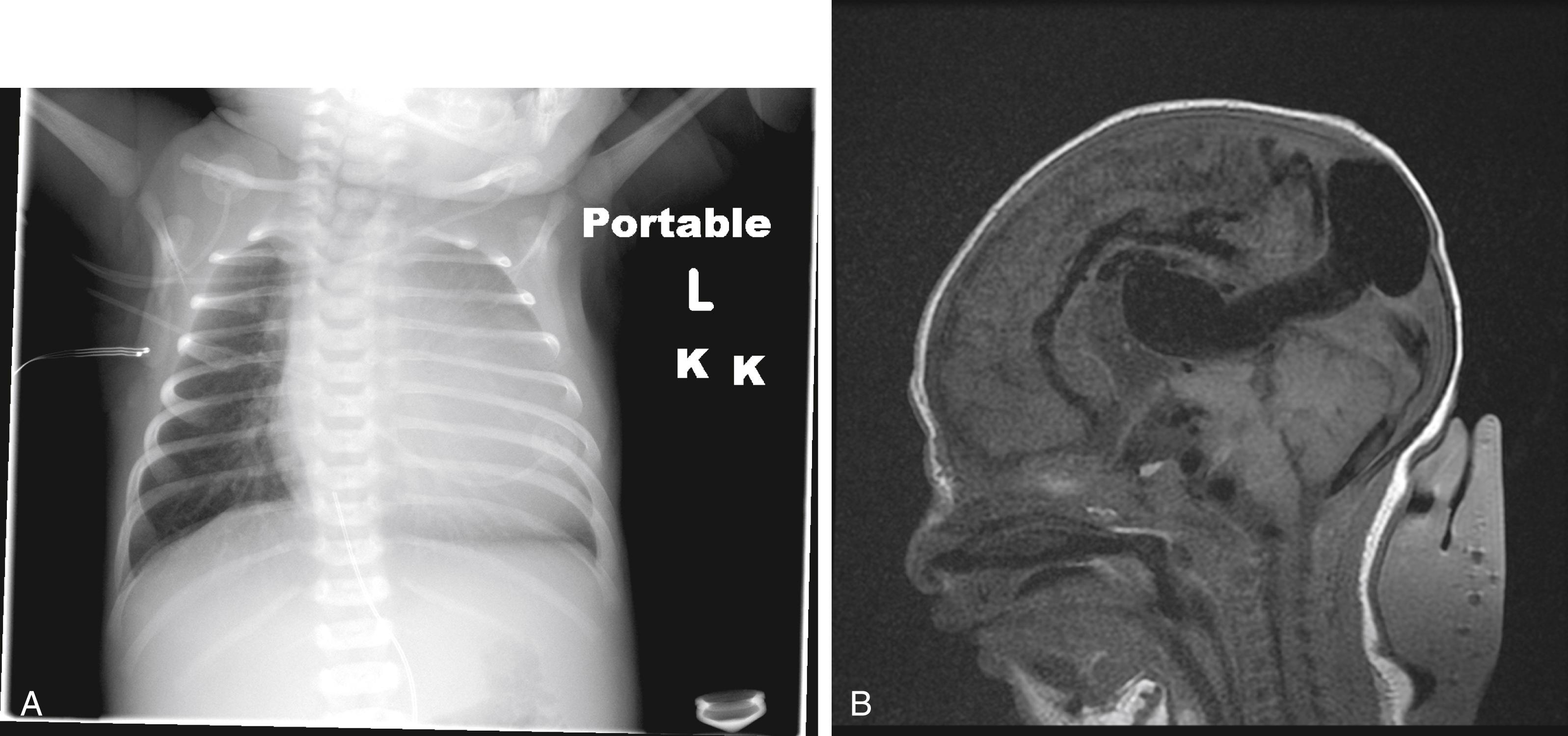
When the abdomen is examined, it often helps to gently flex the hip on the side being examined because this relaxes the abdominal muscles. Most structures in the abdomen are smaller (pyloric olive), softer (liver), more superficial (spleen tip), or deeper (kidneys) than expected. The use of any part of the hand other than the fingertips should be discouraged because maximal sensitivity is essential.
Careful evaluation of the hip joints is a crucial part of each newborn examination because identification and early treatment of congenital dislocation can prevent later disability. Although asymmetry of the buttocks and skin creases or asymmetry of femoral length can be clues to dislocation, the performance of at least one of several active motion tests is essential. The Ortolani and Barlow maneuvers involve placing the third or fourth finger over the greater trochanter and the thumb on the medial aspect of the thighs. The thighs are first adducted to try to dislocate a dislocatable hip and then abducted with the fingers pushing toward the midline and the thumbs away from midline to relocate a dislocated hip. These maneuvers should be performed on one hip at a time. A definite “clunk” can be felt and often heard, in the first 45 degrees of movement, if the femoral head has been dislocated and then moves back into the acetabulum.
This can be differentiated from hip subluxation (partial dislocation) where there is no true “clunk” but the hip moves with a sliding motion. There are higher-pitched clicks and snaps felt or heard with hip subluxation that may represent nothing more than tendons passing over bone or cartilage. Hip subluxation still requires close follow-up.
One of the unique considerations in the examination of the newborn is the assessment of gestational age. Accurate determination should be the first part of any newborn examination, because this provides the context for the remainder of the evaluation. No differential diagnosis of newborn disease can be made without knowing whether the patient is premature or full term and whether he or she is small, large, or appropriate for gestational age (AGA). Although an accurate menstrual and pregnancy history usually provides evidence of gestational age, there are many cases in which such data are unavailable or unreliable.
Many investigators have developed examination criteria, both morphologic and neurologic, for the assessment of gestational age. Although these criteria are generally useful because of the ordered patterns of fetal development, the clinician cannot rely on any single feature or even a small group of features to develop at the same rate in all infants. In fact, assessment of paired structures, such as ears, may reveal slightly different degrees of maturation from one side to the other. Thus, all the available methods involve numerous physical and neurologic items and have, at best, a 2-week range of error.
Although morphologic criteria tend to be uninfluenced by events occurring around the time of delivery, neurologic findings may be unreliable in the presence of several conditions, including depression secondary to medication, asphyxia, seizures, metabolic diseases, infections, and severe respiratory distress. Even morphologic criteria may be inaccurate if the infant is born with severe edema, growth retardation, or side effects from maternal drug use. Such factors must be considered in estimating gestational age.
The Ballard assessment for gestational age determination of newborns uses six morphologic and six neurologic criteria to estimate gestational age based on an examination performed at 12 to 24 hours of life ( Fig. 2.2 ). Individual findings are scored on a scale of 0 to 5, and the total score is compared with the chart shown in Fig. 2.2 .
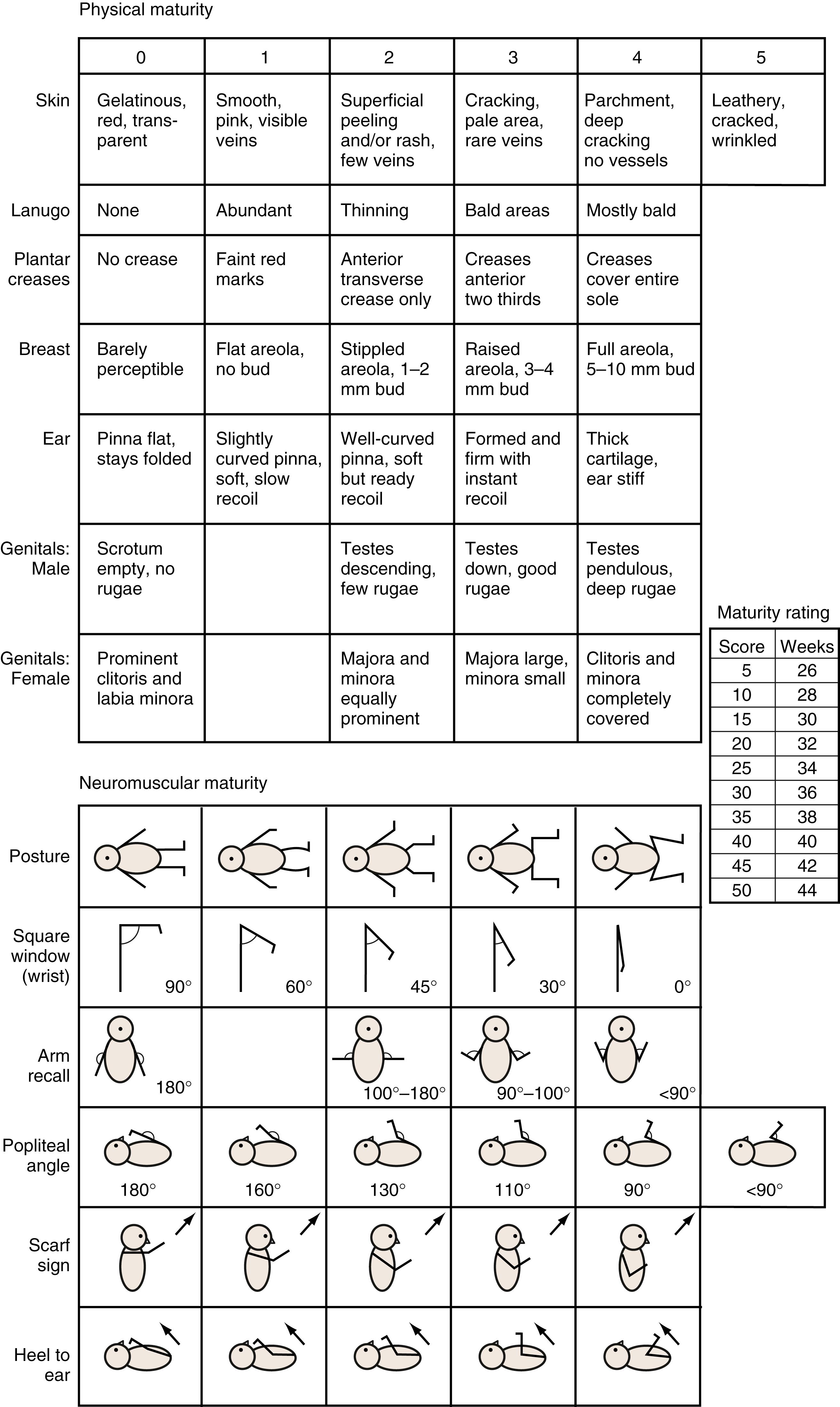
One of the most striking differences among newborns of various gestational ages is the quality of the skin. The chemical nature of skin changes during intrauterine development, with a gradual decrease in water content and a thickening of the keratin layer. Very premature infants (24 to 28 weeks) have nearly translucent, paper-thin skin ( Fig. 2.3 ) that is easily abraded. A diffuse red hue and a prominent venous pattern are characteristic. At term, the skin no longer appears thin, and the general color is a pale pink. Some superficial peeling and cracking around the ankles and wrists may be visible. Post-term infants (42 to 44 weeks) often have more diffuse peeling and cracking of the skin because the outermost layers are sloughed ( Fig. 2.4 ).
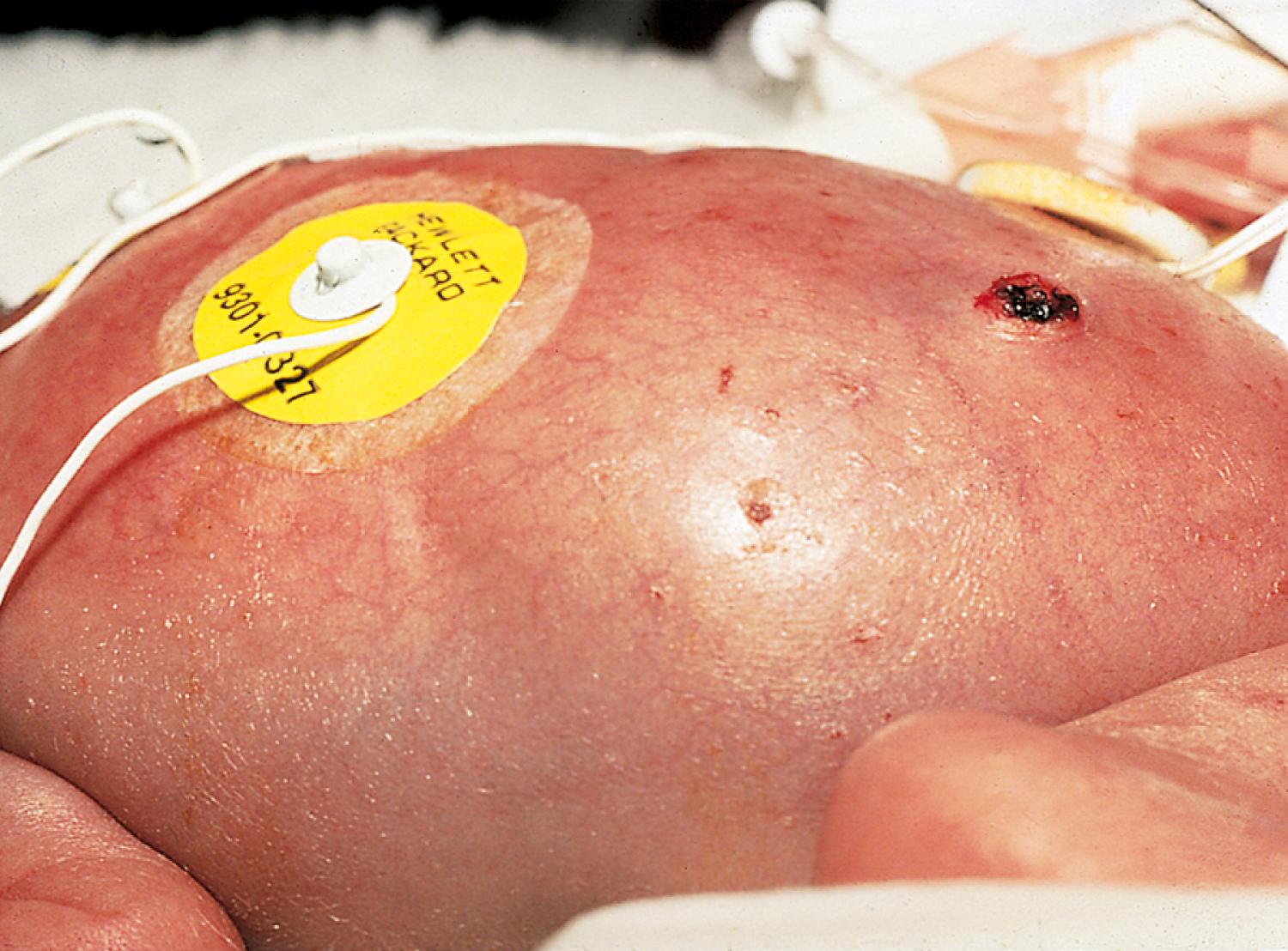
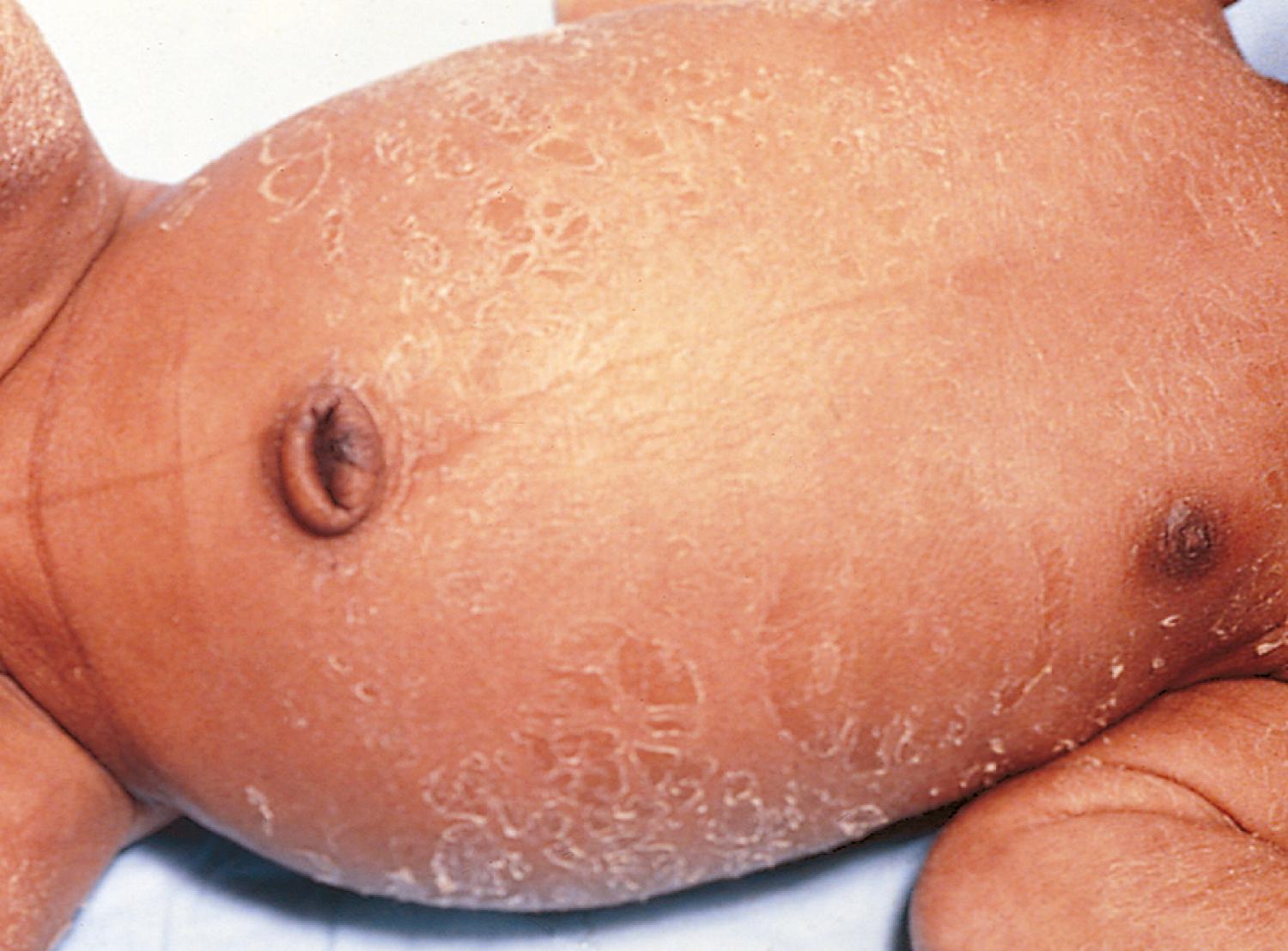
The general quality of scalp hair changes during development from rather fine, thin hair (24 to 28 weeks) to coarser, thicker hair (term). Racial differences in hair quality can make this change difficult to assess. Lanugo, a fine body hair that resembles peach fuzz, appears and disappears during development. It is absent before weeks 20 to 22, becomes diffuse until weeks 30 to 32, and then begins to thin. Assessment of the presence and extent of lanugo is best accomplished by observing the back tangentially ( Fig. 2.5 ).
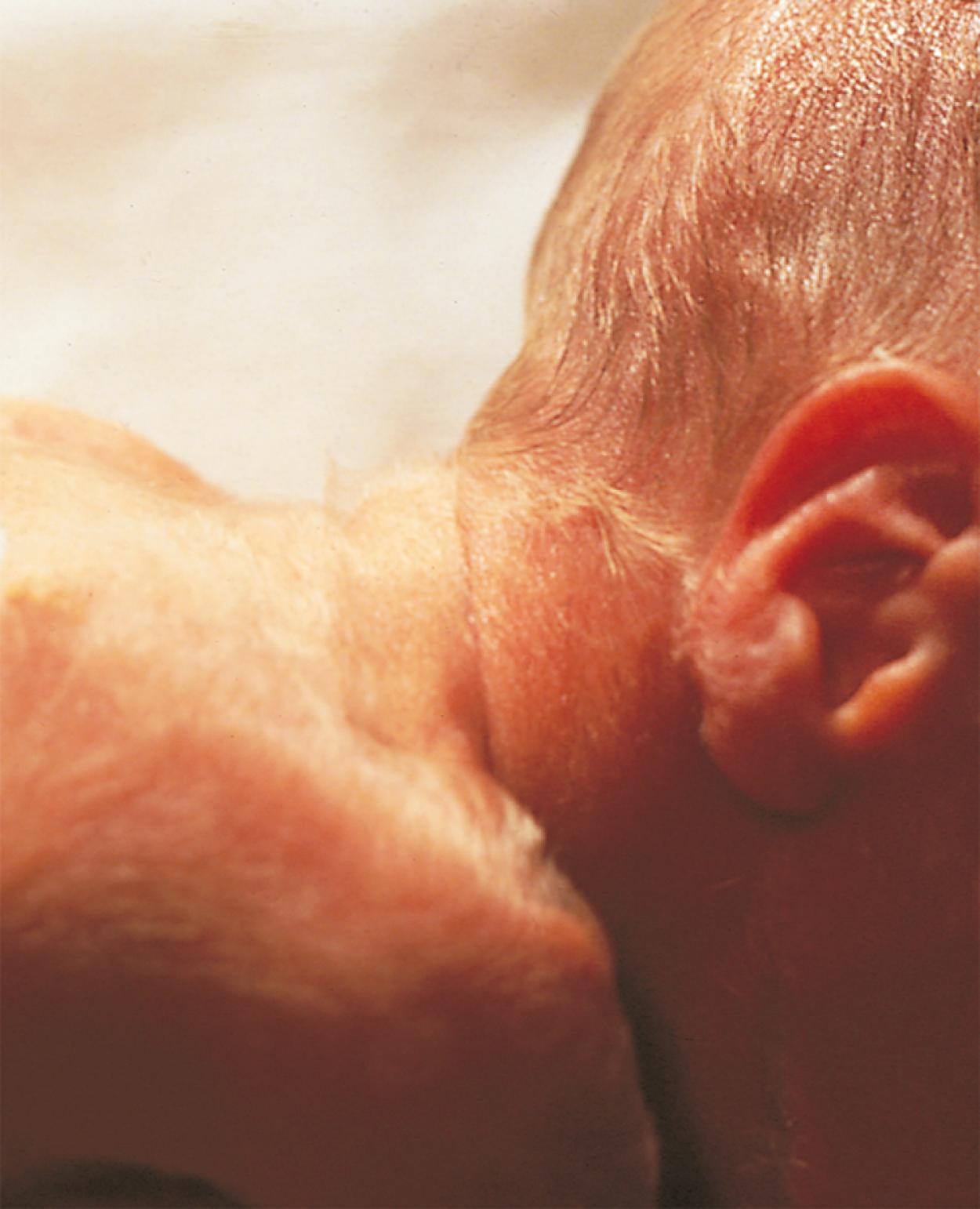
Transverse creases begin to appear on the anterior portion of the soles of the feet at approximately 32 weeks ( Fig. 2.6 ). By 36 weeks, the anterior two-thirds of the sole is covered with creases. For adequate assessment of this feature, it is necessary to stretch the skin over the sole gently to distinguish wrinkling from true creases. Infants with congenital neurologic dysfunction involving the lower extremities and infants with pedal edema may lack normal creases.
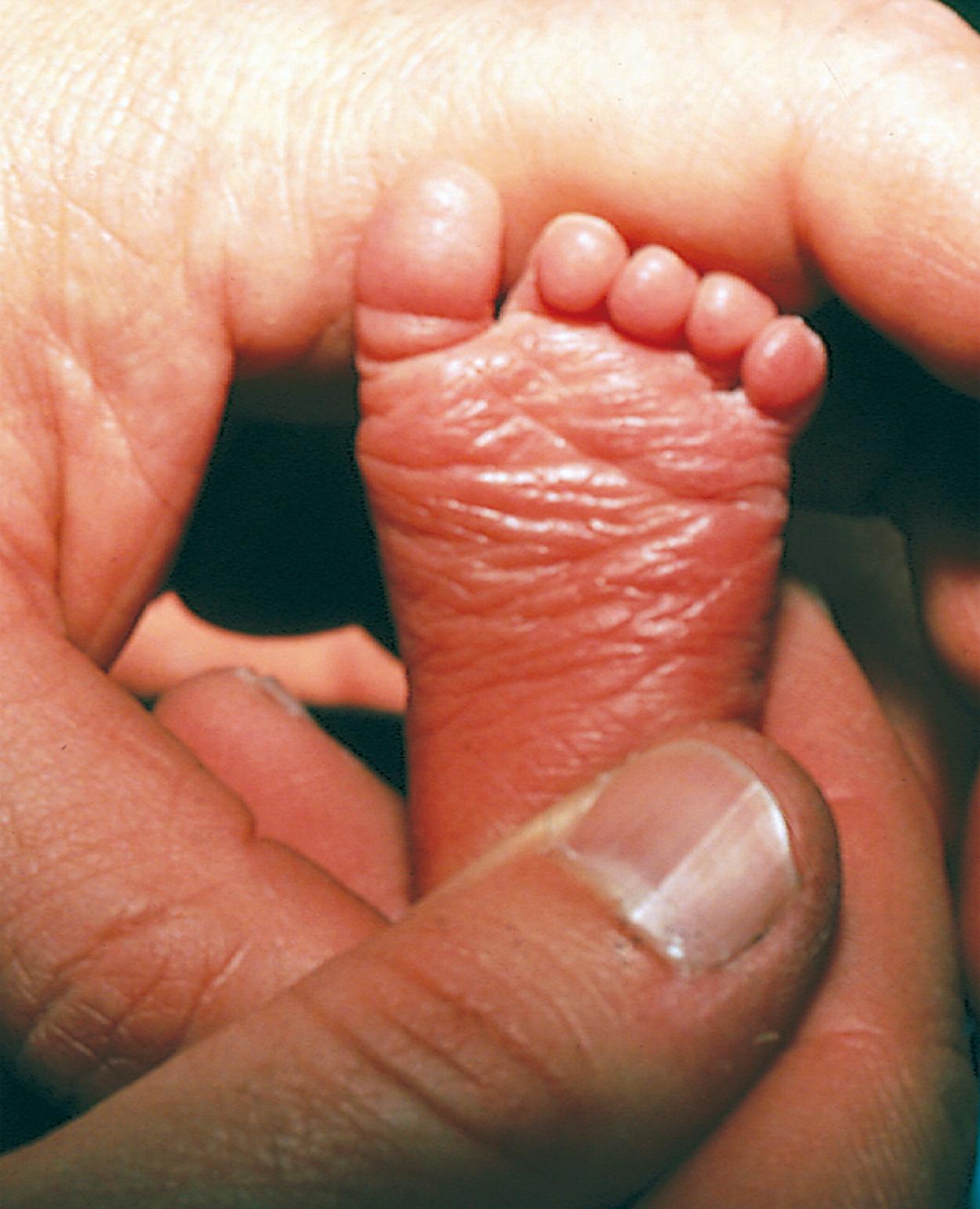
Breast tissue, which is responsive to maternal hormonal influences, shows progressive increase in size as gestational age advances. Infants born at younger than 28 weeks’ gestation have barely perceptible breast tissue (see Fig. 2.3 ). With advancing gestational age, breast tissue increases in size (see Fig. 2.4 ) and, occasionally, a term infant has active glandular secretions, which resolve spontaneously. Breast tissue can remain palpable for 2 to 3 months.
Cartilaginous development proceeds in an orderly manner during gestation and can be assessed by examination of the external ear. Although the normal incurving of the upper pinnae begins at 33 to 34 weeks and is complete at term, it is more reliable to assess the extent of cartilage in the pinnae by feeling its edge and folding the ear ( Fig. 2.7 ). Until approximately 32 weeks, there is only minimal recoil of a folded ear, but by term there is instant recoil.
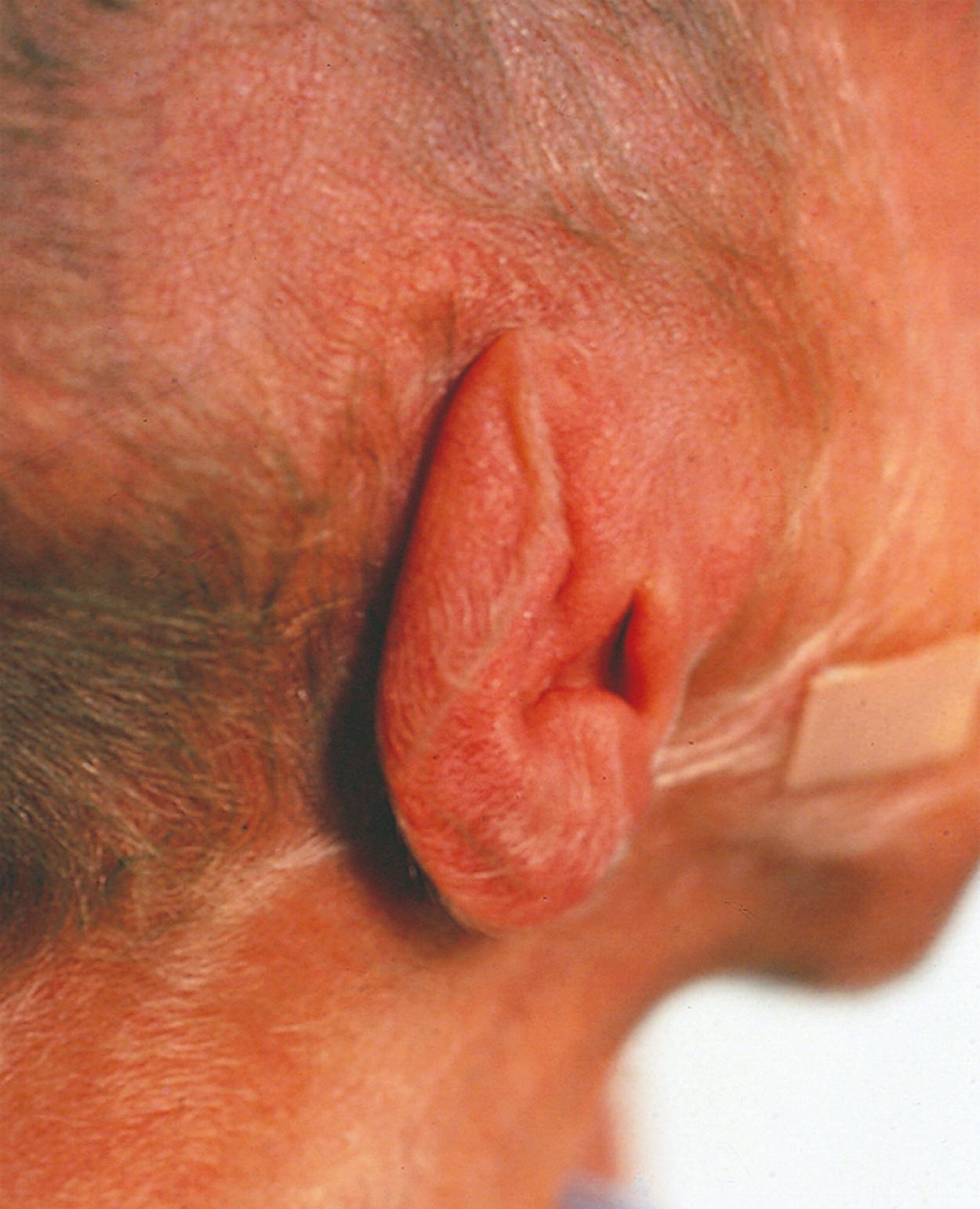
The appearance of the genitalia can be used to assess gestational age. In a boy, the testes descend into the scrotum during the last month of gestation, but they are often palpable in the inguinal canal by 28 to 30 weeks. The appearance of rugae on the scrotum parallels testicular migration, appearing first on the anterior scrotum at 36 weeks and covering the entire scrotal sac by 40 weeks. Absence of testicular descent alters the appearance of the scrotum at term. Clearly, congenital cryptorchidism complicates this evaluation. In a girl, the labia majora tend to be overshadowed by the clitoris and labia minora until 34 to 36 weeks ( Fig. 2.8 ). In cases of fetal malnutrition, lack of subcutaneous fat, which should normally be present in the latter part of gestation, can interfere with assessment of the female genitalia.
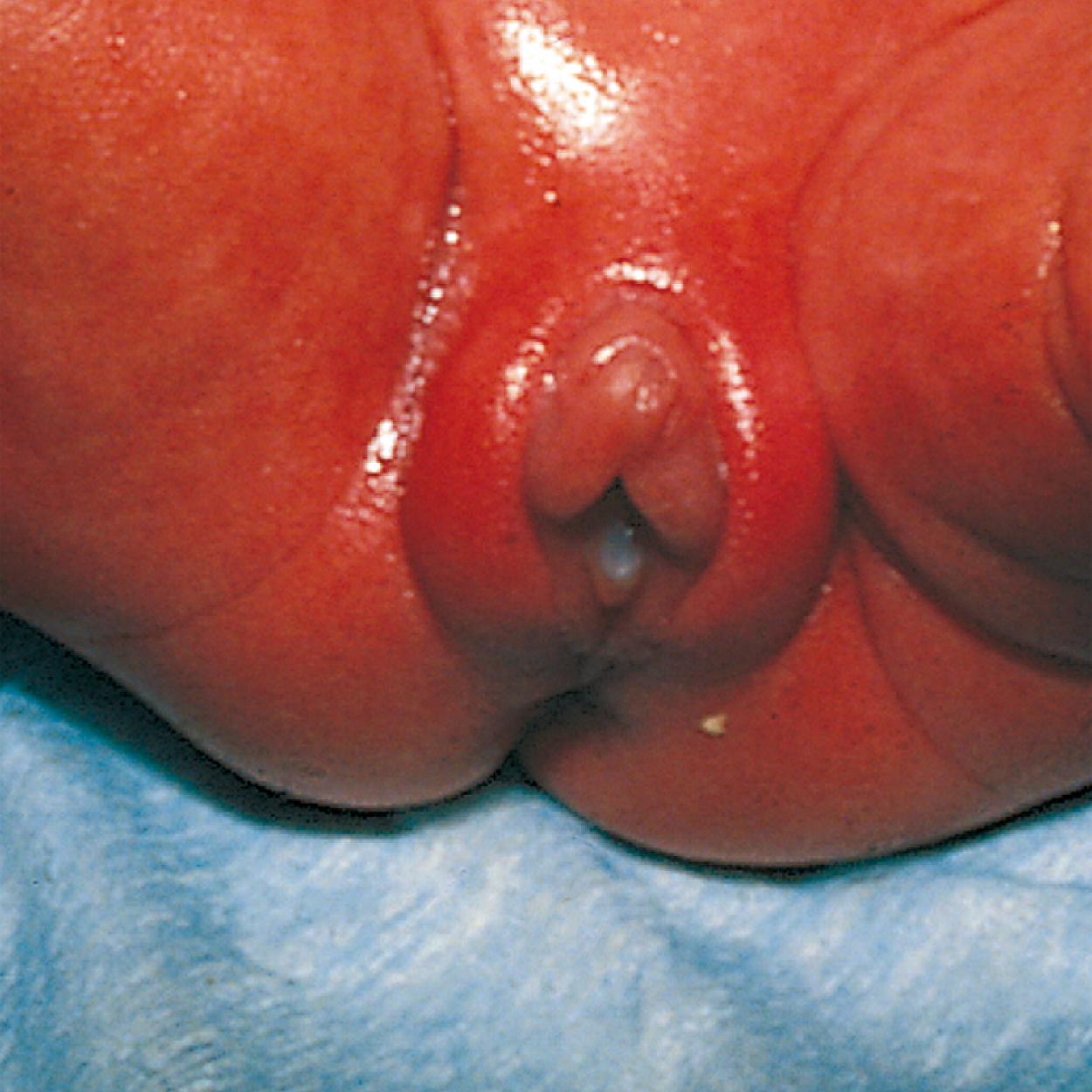
Numerous neurologic tests and observations can be used to assess gestational age. Most examiners use the tests that seem to best cover the various facets of neurologic function including range of motion, tone, reflexes, and posture. None is particularly reliable in the presence of illness, and the entire neurologic examination is best completed between 12 and 24 hours after birth to allow recovery from the stress of delivery.
The resting supine posture of the infant changes with advancing gestational age. The mature infant exhibits a marked flexor posture of the extremities compared with the extensor posture of the premature infant ( Fig. 2.9A and B ).
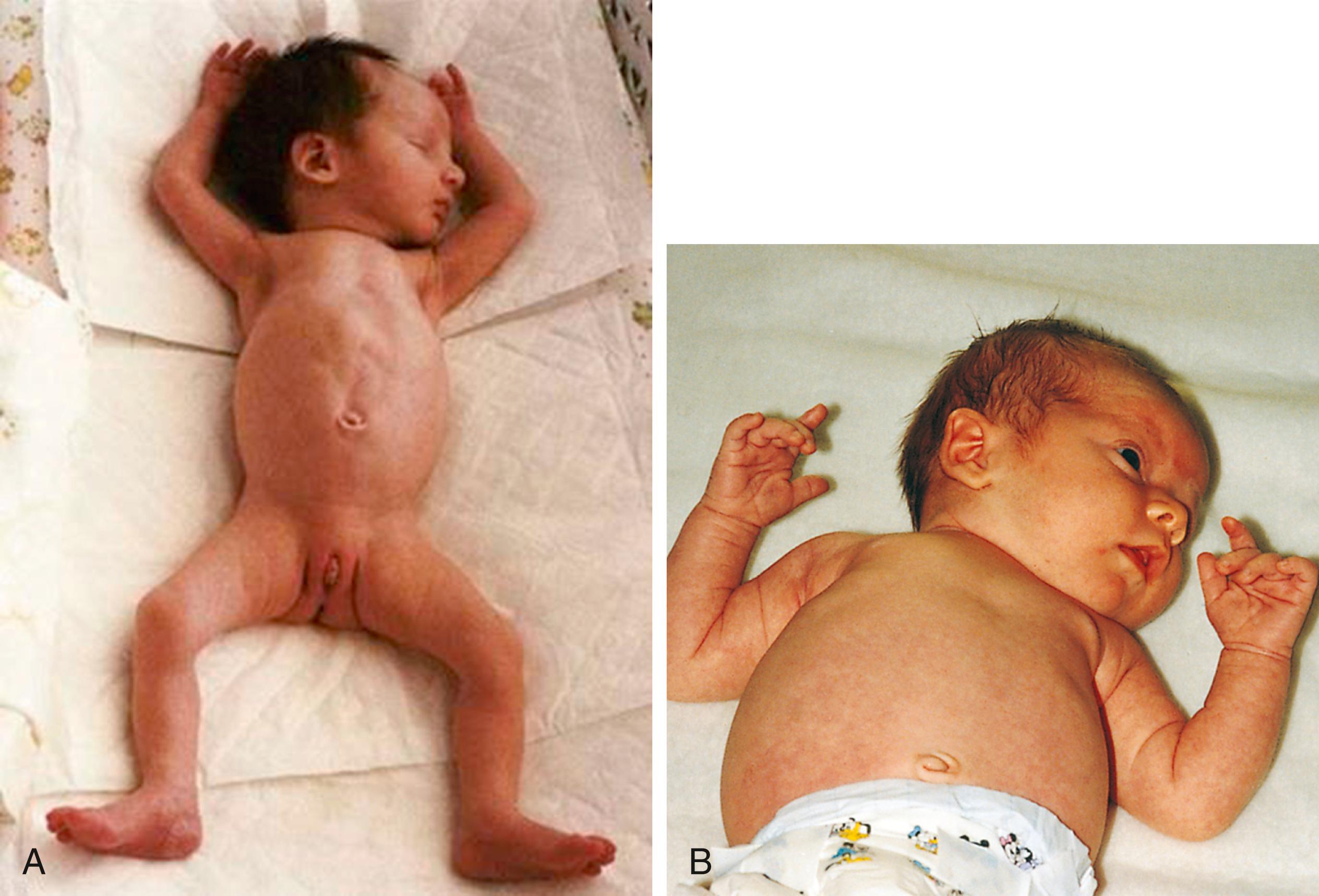
Tests for flexion angles assess a combination of muscle tone, ligament and tendon laxity, as well as flexion/extension development. The inexperienced examiner usually assumes that the very premature infant is the most flexible, but observation of flexion angles demonstrates that this is false. The square-window test of the wrist ( Fig. 2.10 ) is performed by gently flexing the hand on the wrist and assessing the resultant angle. The wrists of babies younger than approximately 32 weeks can be flexed only to 45 to 90 degrees, whereas the wrists of term infants undergo full flexion. Sometime between birth and adulthood this flexion ability is lost. Examination of the flexion of the knees reveals a different pattern of development, with decreasing flexibility as gestational age increases. The knee is completely flexed ( Fig. 2.11A ), and the thigh is stabilized against the stomach. The leg is extended by raising the foot ( Fig. 2.11B ). Gentleness is essential in these evaluations, because any result can be achieved if the examiner applies undue force.
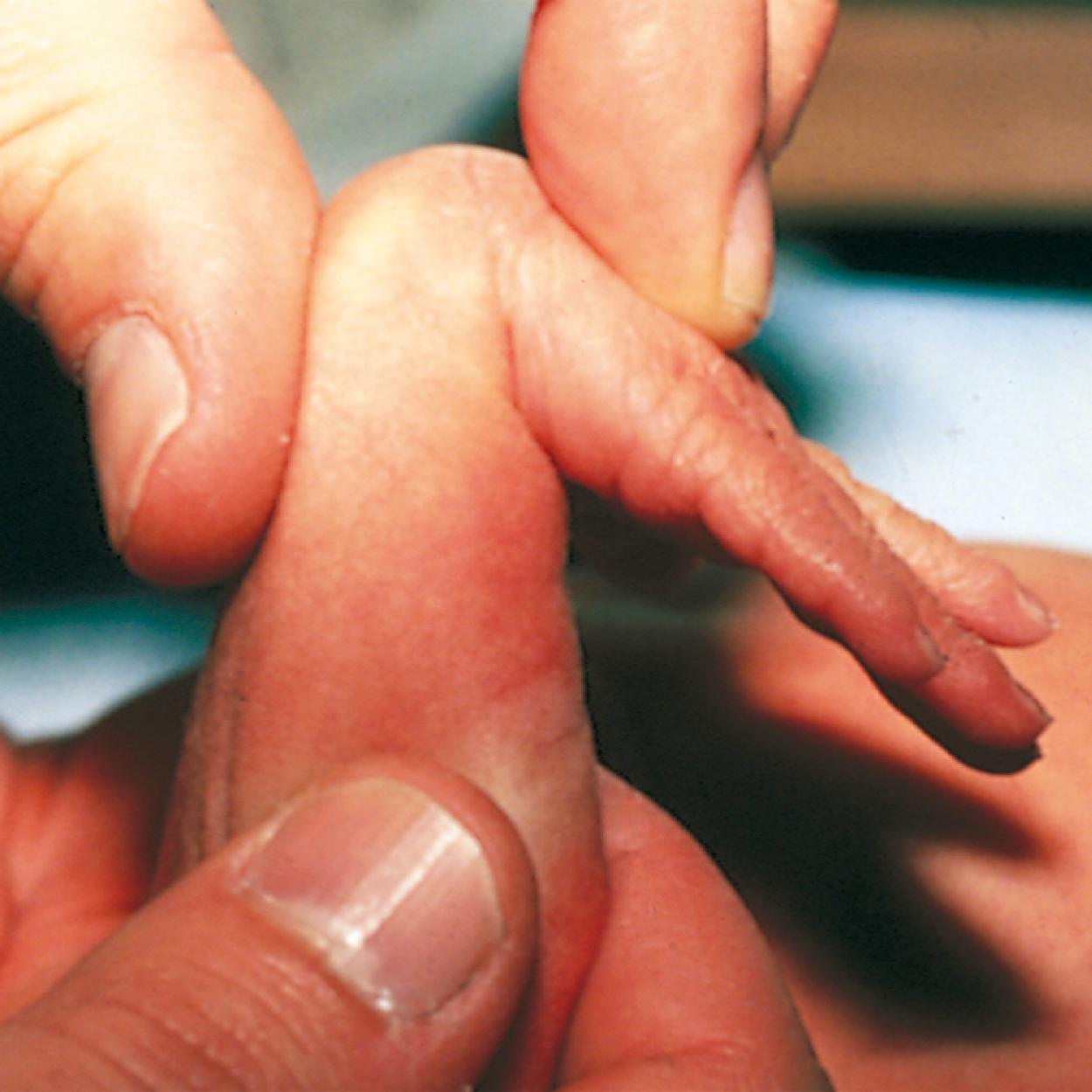
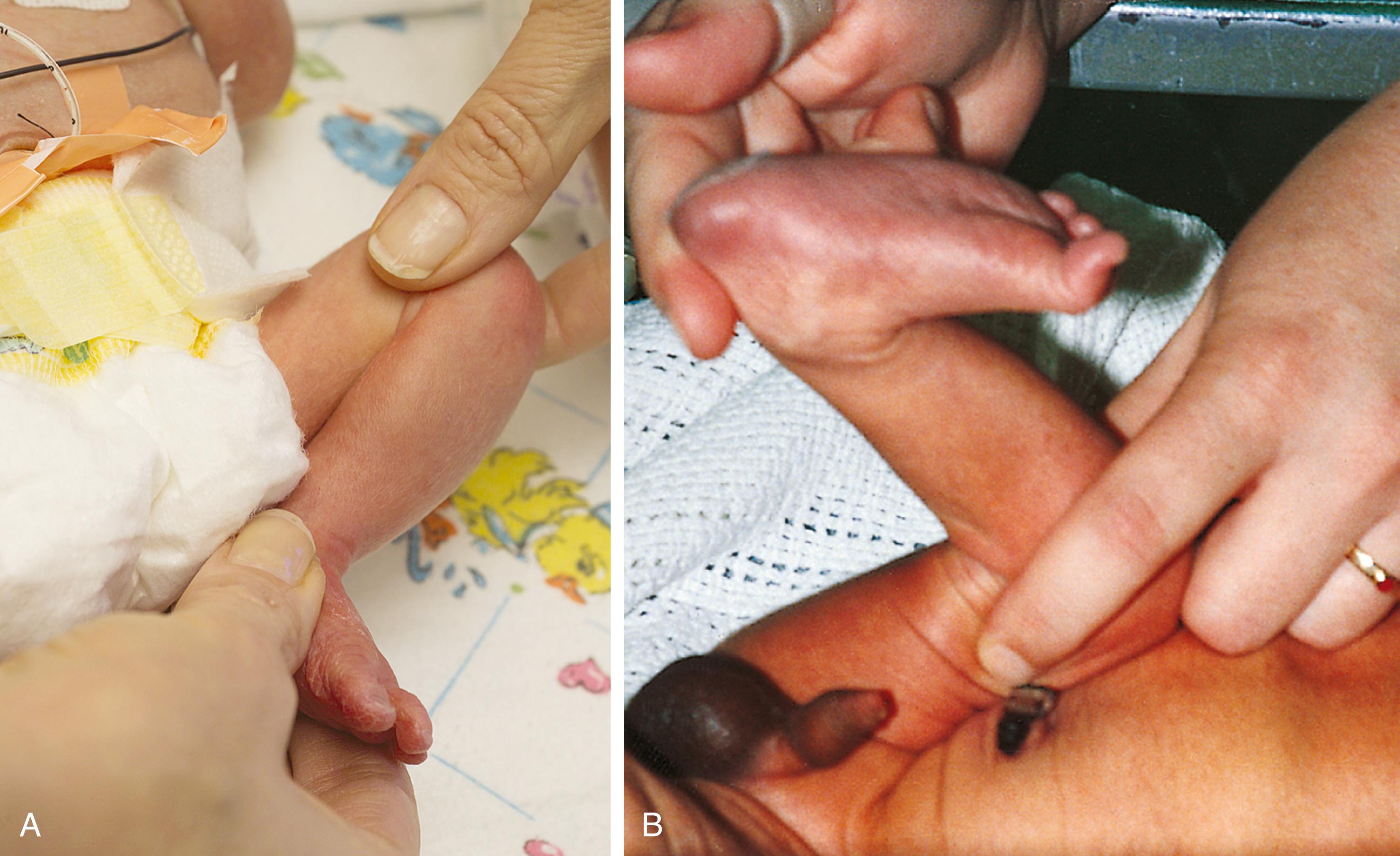
Examination of arm recoil can assess active tone and reflex responsiveness. In this maneuver, the supine infant’s forearms are fully flexed for 5 seconds ( Fig. 2.12A ), then extended by pulling on the hands, and then released. As gestational age increases, the flexion response is more pronounced.
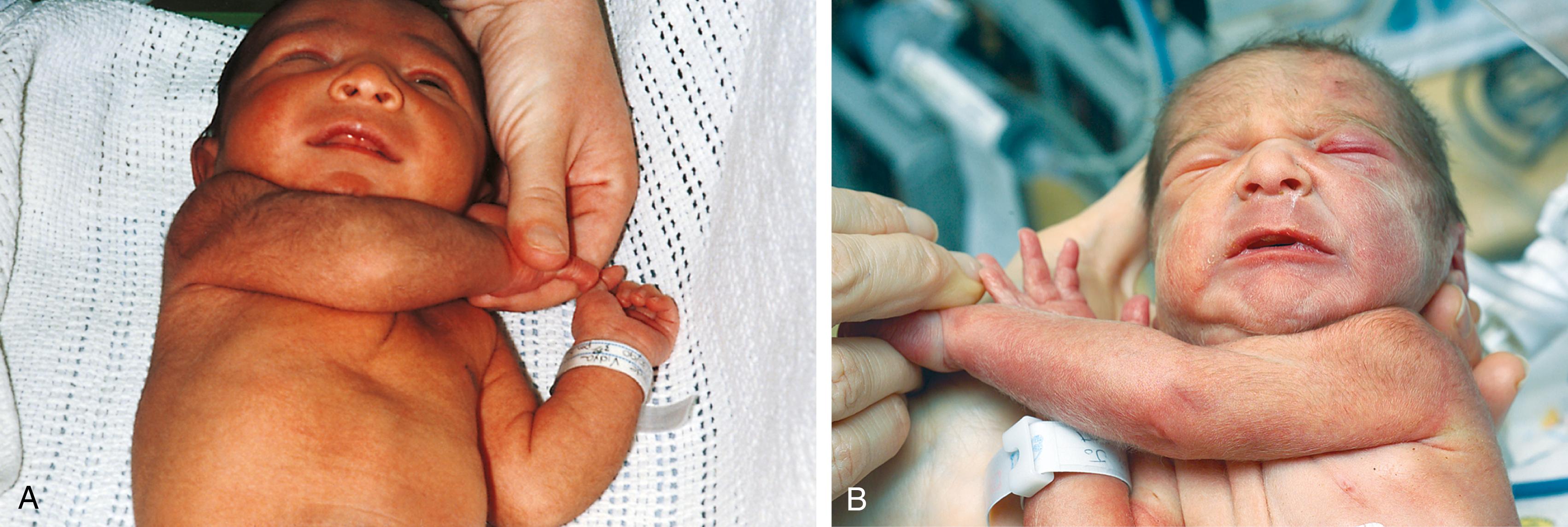
The resting tone of the upper extremities can be assessed by eliciting the scarf sign. Gentle traction of the upper extremities across the chest in a rostral direction (“placing a scarf on the infant”) while examining the position of the elbow reveals a decreasing displacement of the elbow as gestational age increases ( Fig. 2.12B ).
In a similar manner, the resting tone of the lower extremities can be assessed by the heel-to-ear maneuver. With the baby on its back and the pelvis flat, a foot is moved as near to the ipsilateral ear as possible without exerting undue force. Very premature infants can easily touch their heels to their ears ( Fig. 2.13 ). This becomes somewhat more difficult after 30 weeks and impossible by week 34 of gestation.
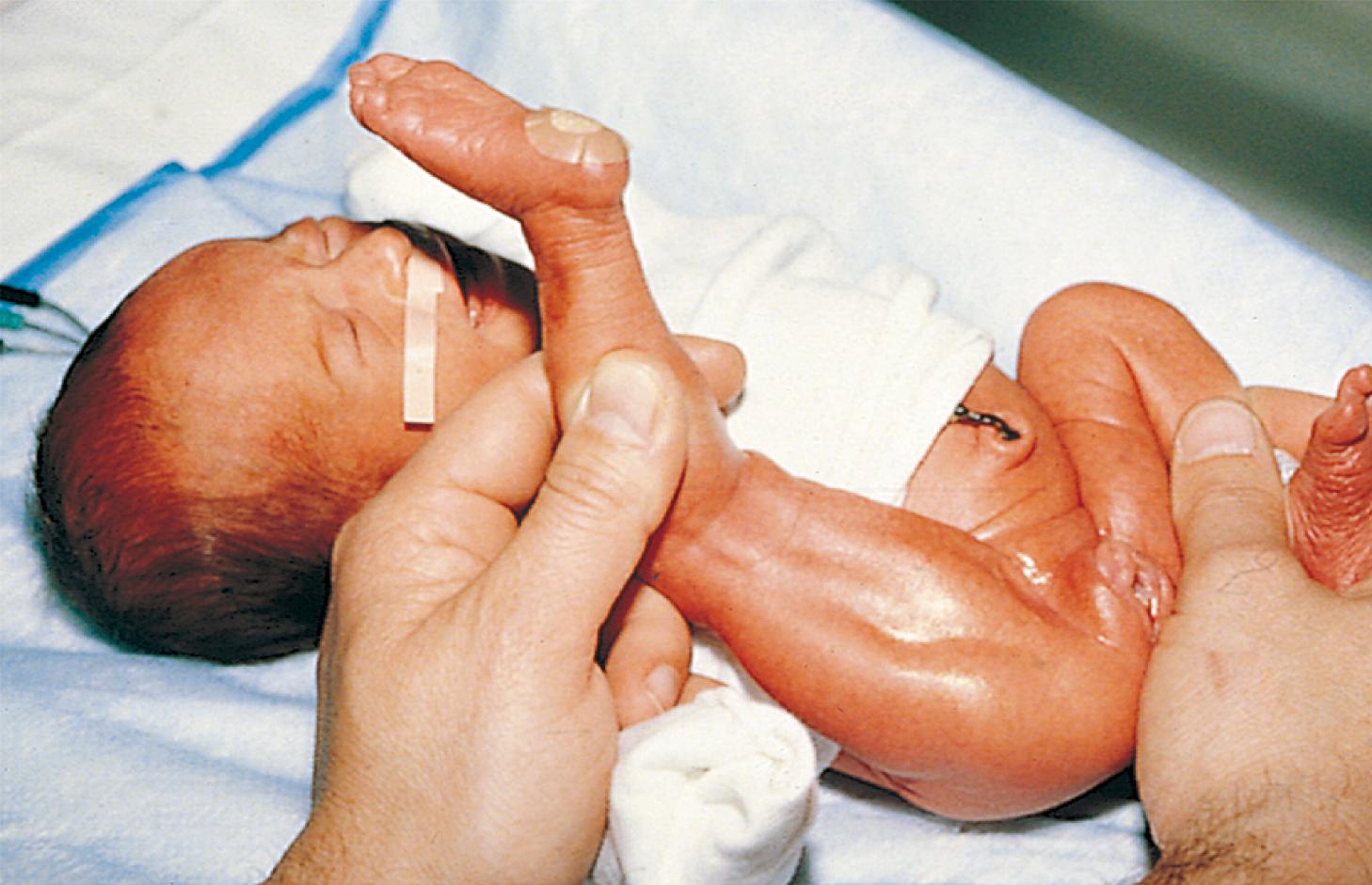
Normal newborns exhibit a number of easily elicited primitive reflexes that are often altered or absent in the infant with neurologic impairment. These reflexes may be transiently depressed in the infant who has difficulty transitioning between intrauterine and extrauterine existence. The persistent absence or asymmetry of one or more of these reflexes may be a clue to the potential presence of neuromuscular abnormalities requiring further investigation (see Chapter 3 ).
The rooting reflex may be elicited by lightly stimulating the infant’s cheek and observing the reflexive attempts to bring the stimulating object to the mouth. The sucking reflex is activated by placing an object in the infant’s mouth and observing the sucking movements. In the grasp reflex ( Fig. 2.14 ), transverse stimulation of the midpalm (without touching the back of the hand) or midsole leads to flexion of the digits or toes around the examiner’s fingers.
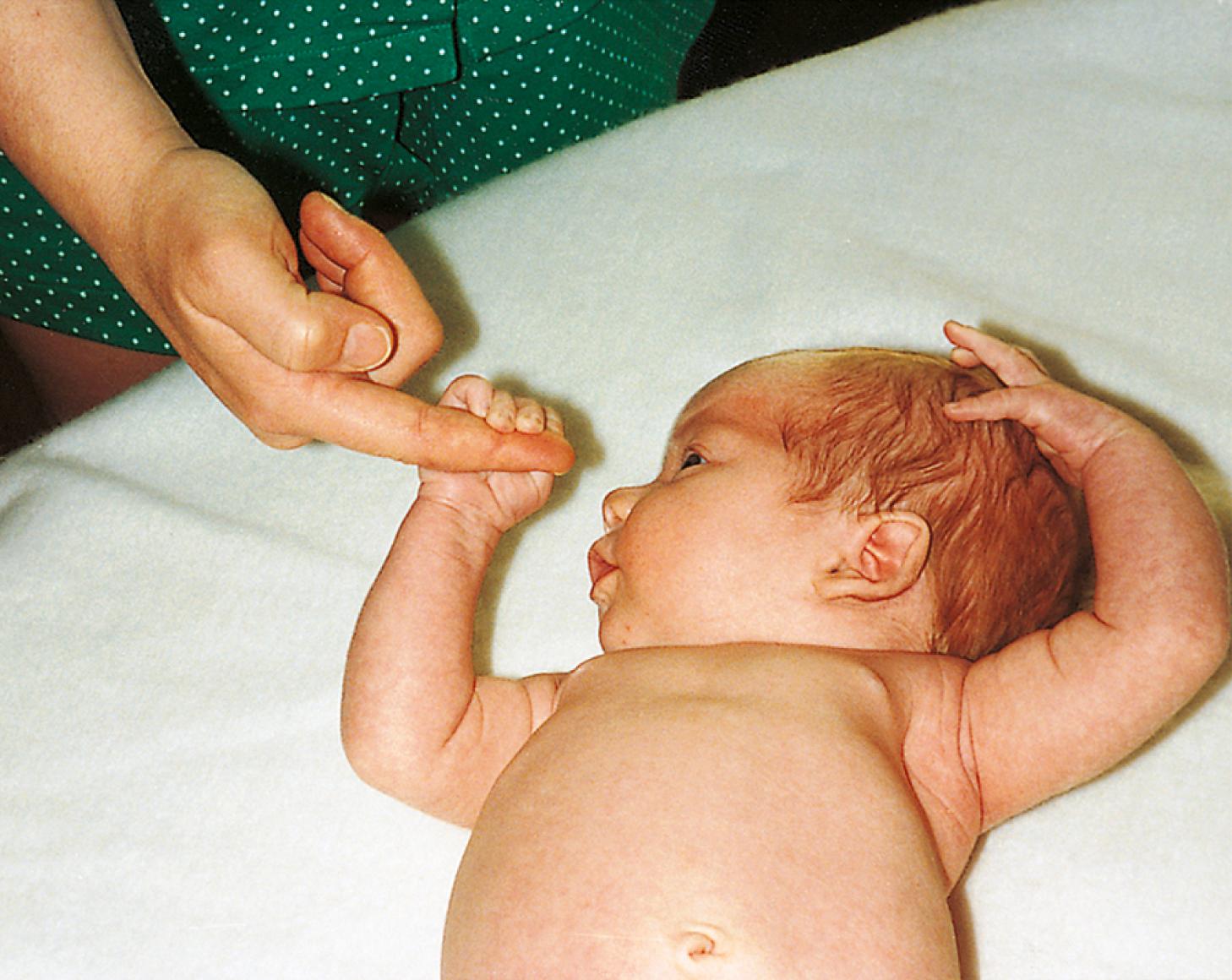
The Moro reflex ( Fig. 2.15 ) evaluates vestibular maturation and the relationship between flexor and extensor tone. Elicitation of the reflex involves a short (10 cm), sudden drop of the head when the infant is supine. The full response involves extension of the arms, “fanning” of the fingers, and then upper extremity flexion followed by a cry. An incomplete but identifiable reflex becomes apparent at approximately 32 weeks’ gestation, and by 38 weeks it is essentially complete. Very immature infants demonstrate extension of the arms and fingers but do not show true flexion or make a sustained cry. Marked asymmetry of response may be associated with focal neurologic impairment.
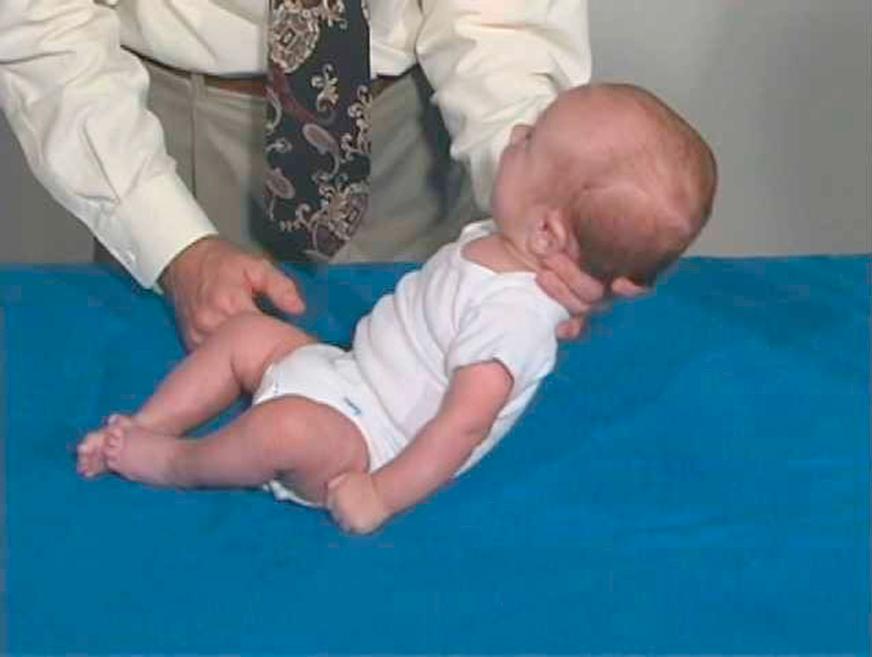
Galant’s infantile reflex is a truncal incurvation reflex. It can be elicited by holding the infant in ventral suspension and stroking from shoulder to hip along one side of the spine. The infant will contract the abdominal musculature and laterally flex toward the stimulated side. Lack of the Galant reflex may indicate a spinal cord lesion ( Fig. 2.16 ).
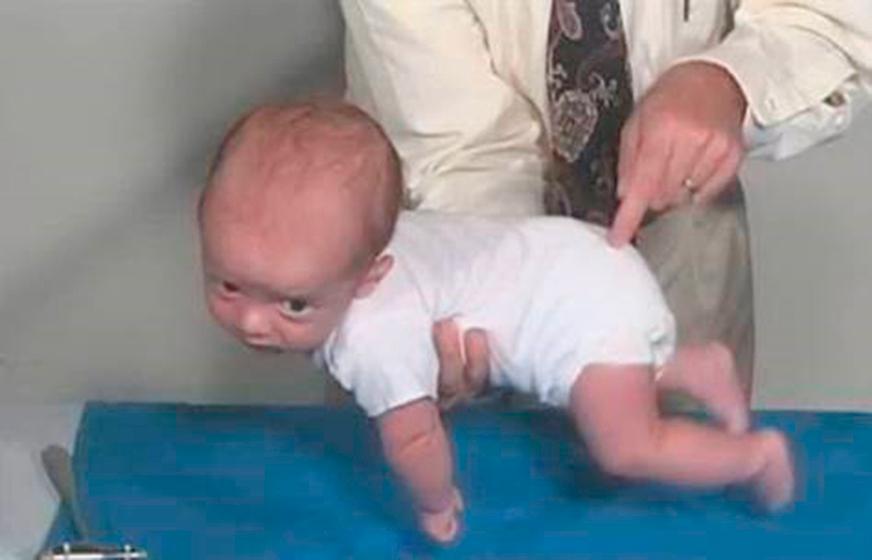
These reflexes and a host of other less commonly used reflexes are termed primitive because they are present at or shortly after birth and normally disappear after the first few months of life. Just as their absence may indicate neurologic impairment at birth, their abnormal persistence may also be a cause for concern and further evaluation.
Intrauterine growth restriction (IUGR), a deviation in the expected fetal growth pattern, complicates up to 8% of all pregnancies and is associated with an increase in perinatal morbidity and mortality. Infants with IUGR may appear long and thin and often have an obvious loss of subcutaneous tissue, which is best seen as redundant skin folds over the buttocks, thighs, and knees. The etiology of IUGR is multifactorial and includes fetal, placental, and maternal factors that inhibit normal fetal growth. The conditions for IUGR and small for gestational age (SGA) are related but not synonymous. The fetus with IUGR generally has a period of normal growth followed by a decrease in growth velocity over time while the diagnosis of SGA is population-specific and includes infants who weigh less than a predetermined cutoff value ( Fig. 2.17 ). There is no universal agreement on the definition of the SGA or large for gestational age (LGA) infant. Birth weights less than the 10th percentile or greater than the 90th percentile for gestational age within a population are often considered to be, respectively, SGA or LGA. Similarly, AGA infants have growth parameters within two standard deviations of the mean, or between the 10th and 90th percentiles.
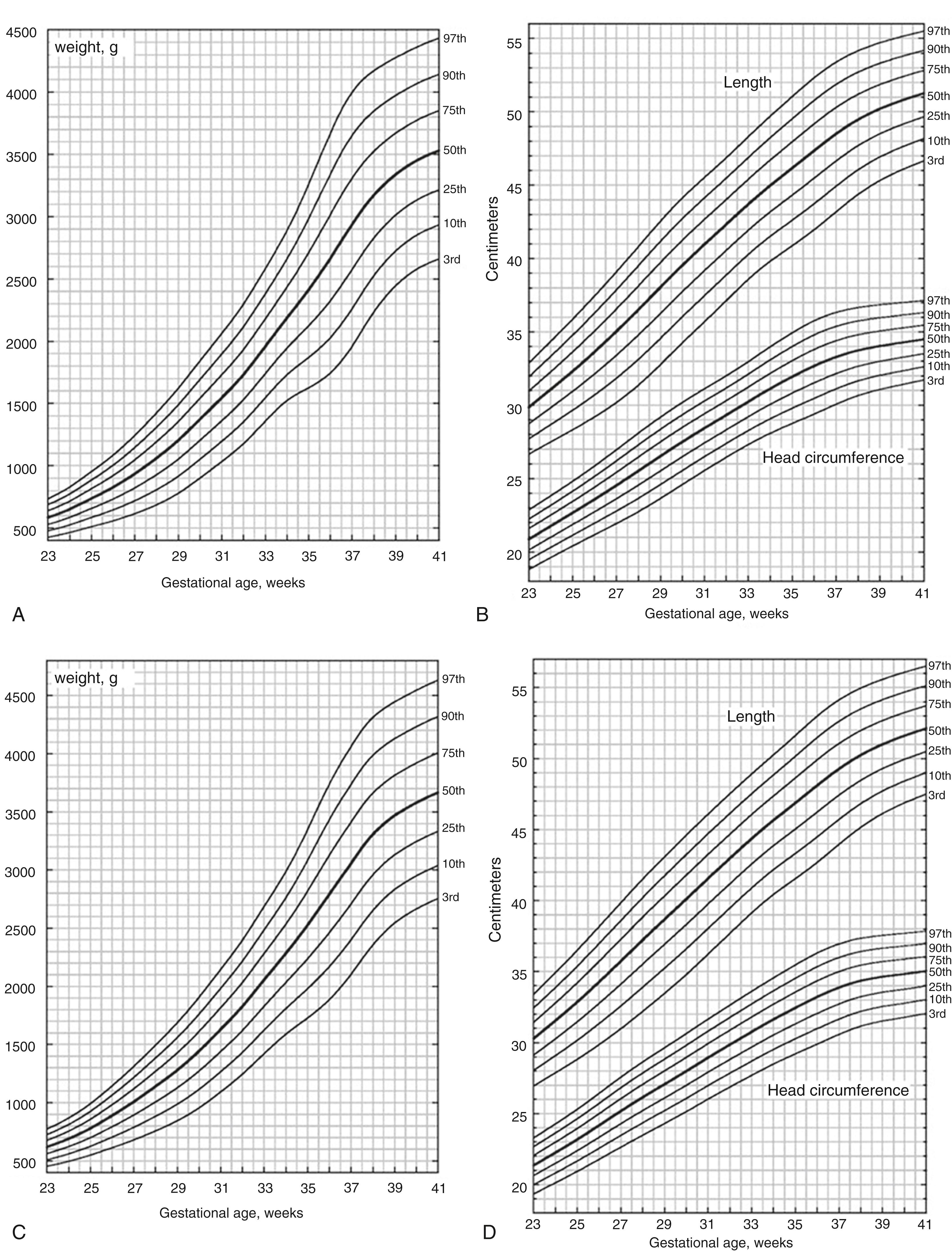
The relationship among weight, length, and head circumference can be useful in understanding the etiology of the small size (see Fig. 2.17 ). By comparing length or head circumference percentiles with the weight percentile at any given gestational age, the clinician can detect growth retardation even if the actual weight still falls within two standard deviations of normal. Conditions that affect growth during the third trimester of pregnancy, such as preeclampsia, tend to interfere with the normal acquisition of fatty tissue while sparing brain growth (and thus head circumference) and linear growth. These newborns have an asymmetrical form of growth retardation ( Fig. 2.18 ). Often post-term infants (>42 weeks) have some decrease in weight compared with length or head circumference. Problems beginning earlier than the third trimester tend to produce generalized growth retardation, with head circumference, weight, and length affected to equivalent degrees. Infants with symmetrical IUGR tend to have higher rates of chromosomal disorders, dysmorphic syndromes, and congenital infection and are associated with higher rates of prematurity and neonatal mortality. In very premature infants, global decreases in growth often complicate assessment of gestational age, because the tools are rather limited in babies born at 24 to 28 weeks’ gestation. A thorough investigation should be undertaken in any unexplained instance of growth retardation.
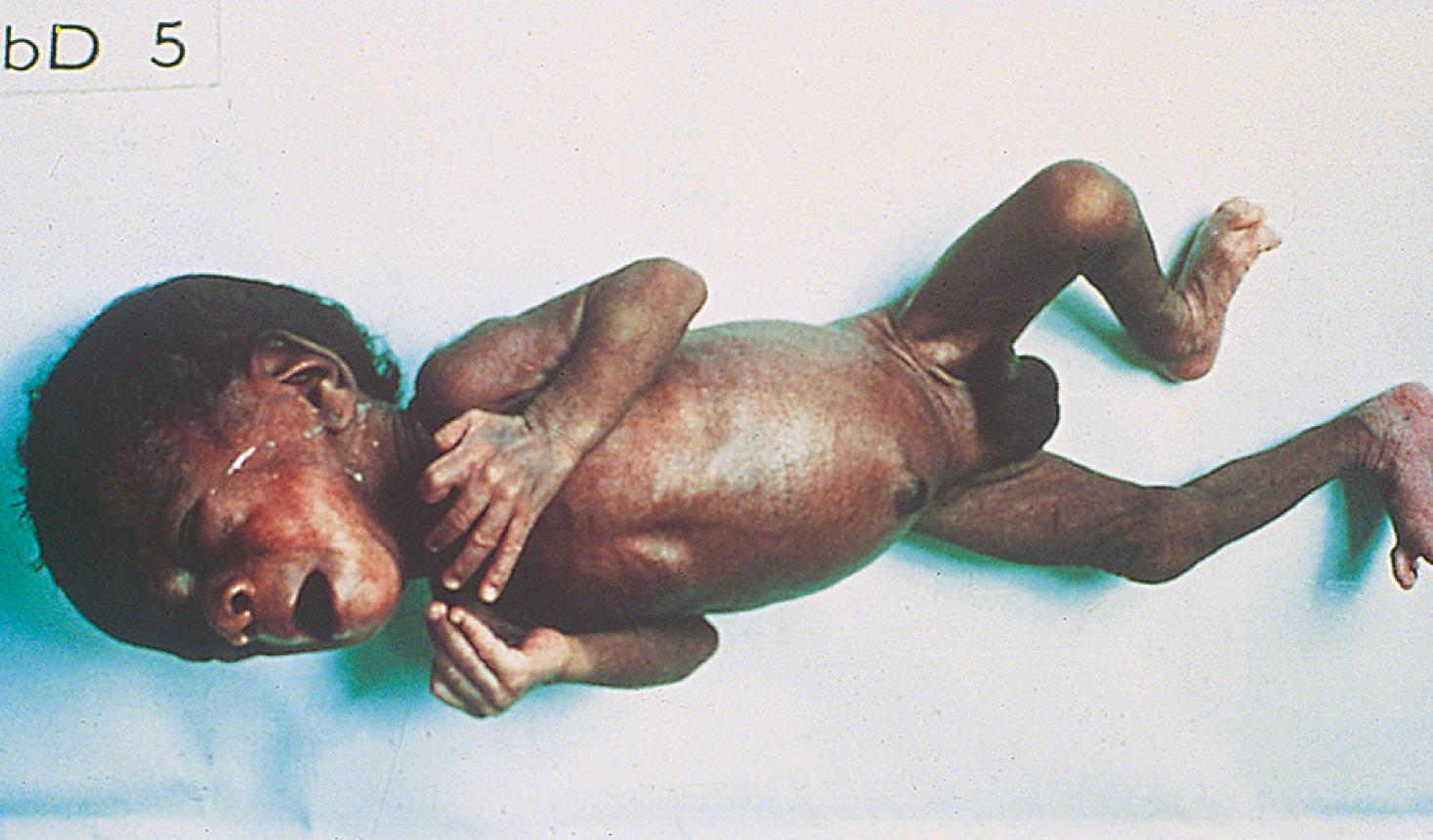
Multiple-gestation pregnancies often produce newborns that are premature and symmetrically small. Fetal growth decreases as the number of fetuses increases. Although multiple factors interfere with growth in these pregnancies, uterine constraint appears to occur when the combined fetal size approximates 3 kg. Size discordance (>10% difference in weight) between identical twins may occur if their placentas share vascular connections, resulting in overperfusion of one twin and underperfusion with subsequent growth restriction of the other. Discordance may also occur in dizygotic twins ( Fig. 2.19 ) if one has placental insufficiency or if only one twin is afflicted with a chromosomal abnormality or congenital infection.
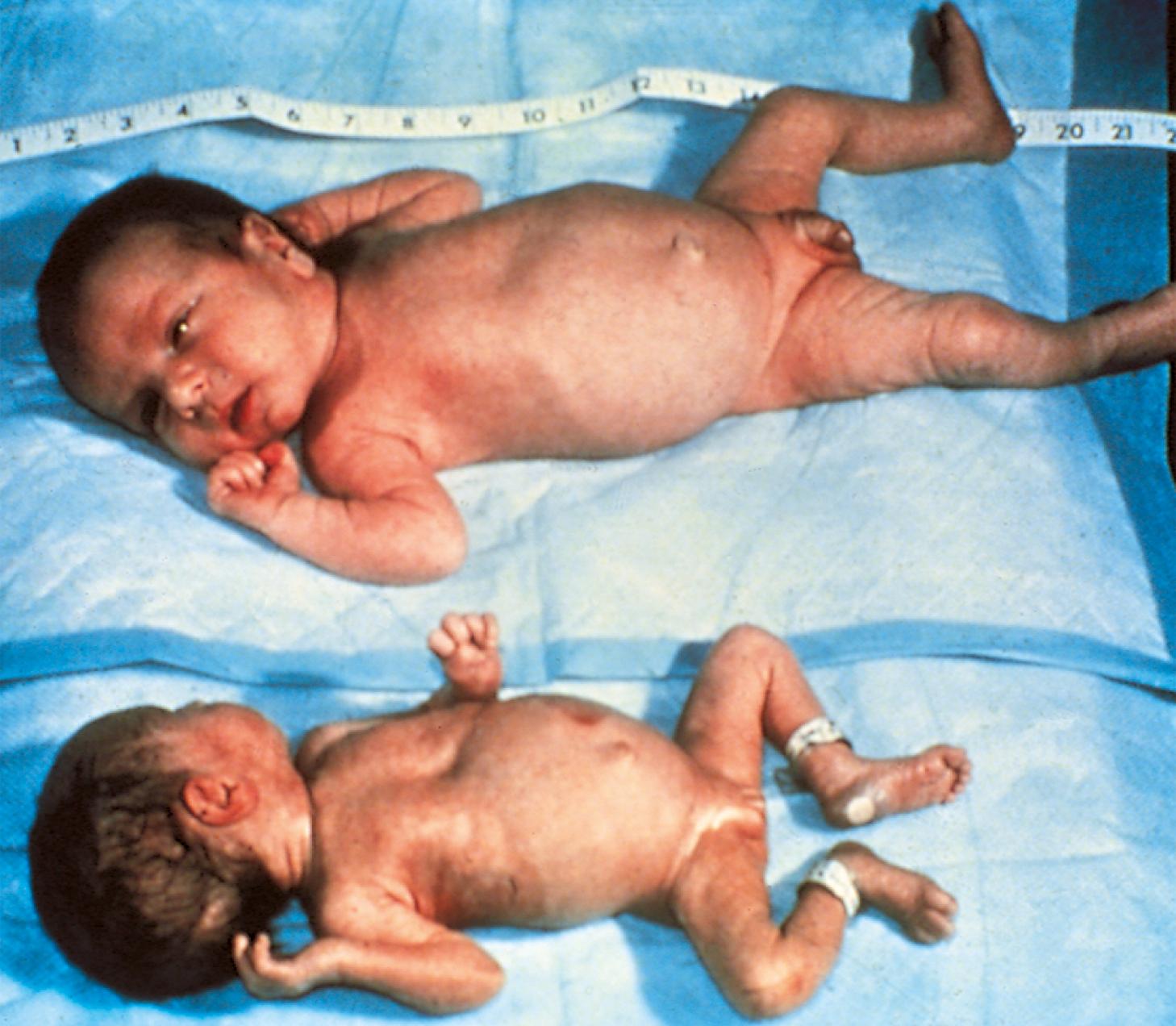
Newborns that are LGA are often the products of pregnancies in diabetic or “prediabetic” mothers. The effect is usually noted during the third trimester, with infants at term who weigh more than 4 kg (8 lbs. 13 oz.). Weight is the most affected parameter, but length and head circumference are often increased as well. Infants of diabetic mothers are often identifiable by macrosomia, round facies ( Fig. 2.20 ), and sometimes plethora and hirsutism (especially of the pinnae). Maternal hyperglycemia results in fetal hyperglycemia and increased insulin production by the fetal pancreas which may result in neonatal hypoglycemia. Maternal hyperglycemia also causes glycogen deposition in the newborn, resulting in visceromegaly, most notable in the liver and heart. Although babies weighing more than 8 pounds are more likely to be from diabetic pregnancies, a significant number of large full-term newborns are the product of normal pregnancies. Nevertheless, all LGA infants should be routinely screened for hypoglycemia and their mothers investigated for the possibility of undiagnosed diabetes mellitus.
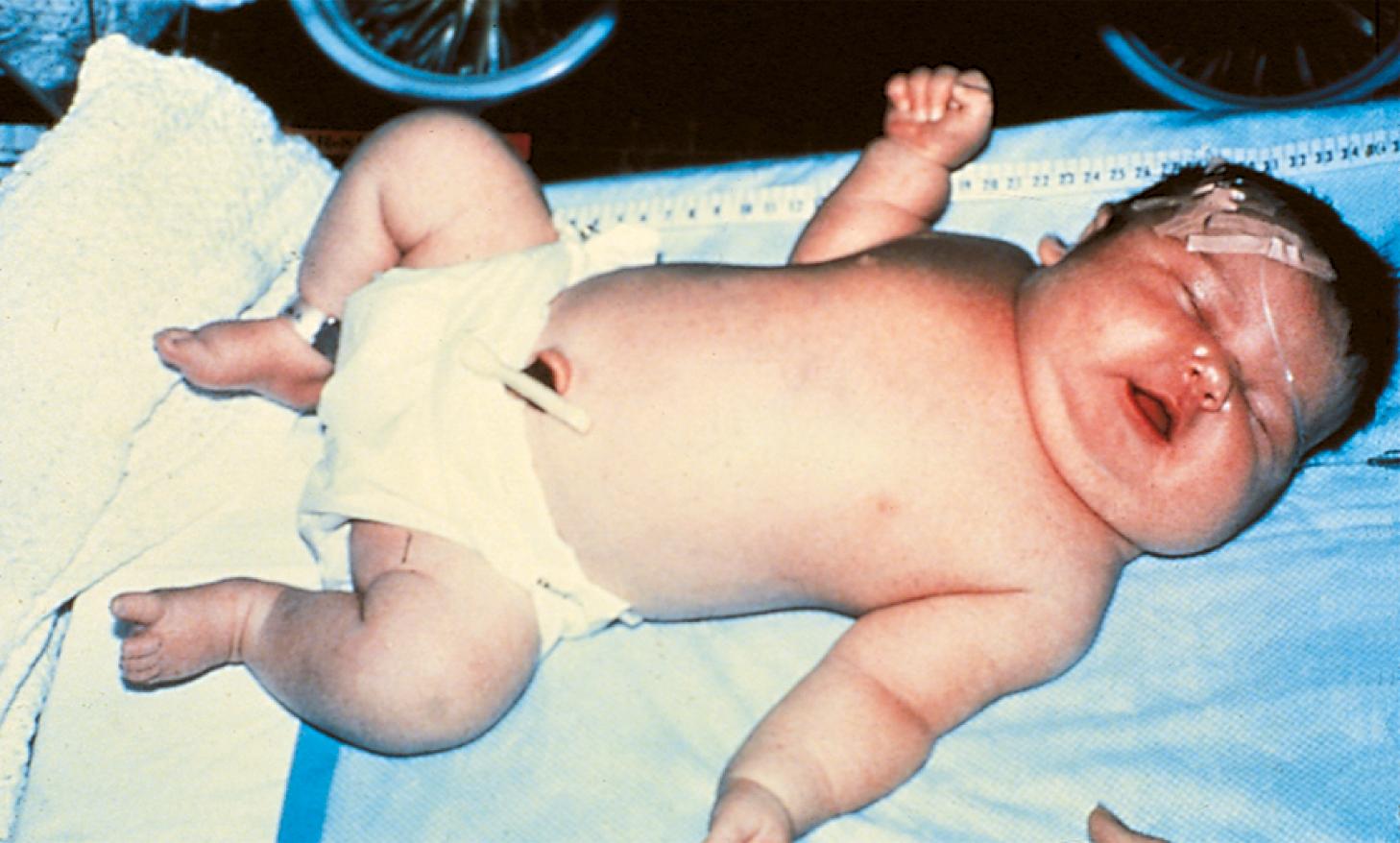
Two fairly unusual syndromes can also cause excessive size: (1) cerebral gigantism, or Sotos syndrome, with macrosomia, macrocephaly, large hands and feet, poor coordination, and variable mental deficiency; and (2) Beckwith-Wiedemann syndrome with macrosomia, macroglossia, omphalocele, linear ear fissures, and neonatal hypoglycemia (see Chapter 9 ).
Careful examination of the placenta can aid in the diagnosis and treatment of many conditions and diseases. Unfortunately, the placenta is often immediately discarded without knowing the condition of the newborn. The configuration, color, condition of the membranes, insertion of the cord, and condition of the fetal and maternal surfaces are all relevant. Communication with the obstetric team allows for further understanding of placental conditions affecting the neonate.
In most cases, a newborn is relatively unscathed by the birth process. However, sometimes transient and permanent stigmata of birth trauma are evident. Prompt identification of such injuries is important for proper management and can also prevent inappropriate speculation, diagnostic testing, and treatment.
Normal transit of the fetal head through the birth canal may cause molding of the skull and scalp edema, especially if labor is prolonged. The edema, which can be significant, is known as a caput succedaneum ( Fig. 2.21 ). Much of this edema is present at birth and tends to overlie the occipital bones and portions of the parietal bones bilaterally. In some cases, such as with vacuum-assisted deliveries, bruising of the scalp may also be present. The presence of a caput requires no therapy, as spontaneous resolution within a few days is typical. Distinguishing caput from a subgaleal (subaponeurotic) hematoma, a rare but serious complication of delivery, is important. A subgaleal hematoma is a collection of blood within scalp tissues extending beneath the epicranial aponeurosis. Palpation of a large caput succedaneum reveals firm, nonpitting swelling. In contrast, the cranial swelling of subgaleal bleeding is fluctuant due to the palpation of blood just beneath the epicranial aponeurosis ( Fig. 2.22 ). The collection of blood in this potential space can be quite large, and these infants must be monitored for signs of hypovolemia and anemia. Serial examinations, which can include measurement of head circumference and hematocrit, are important to identify ongoing blood loss.
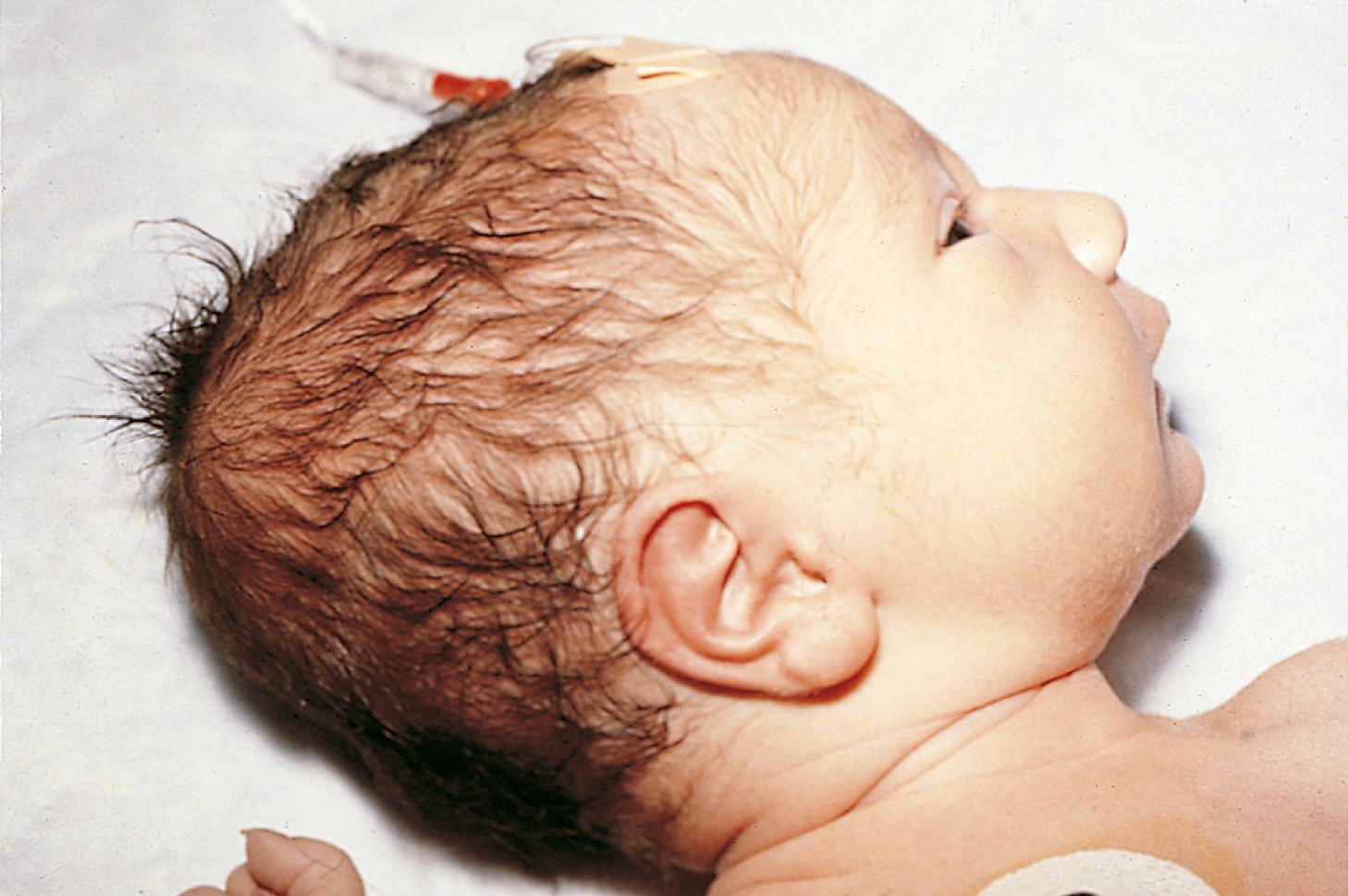
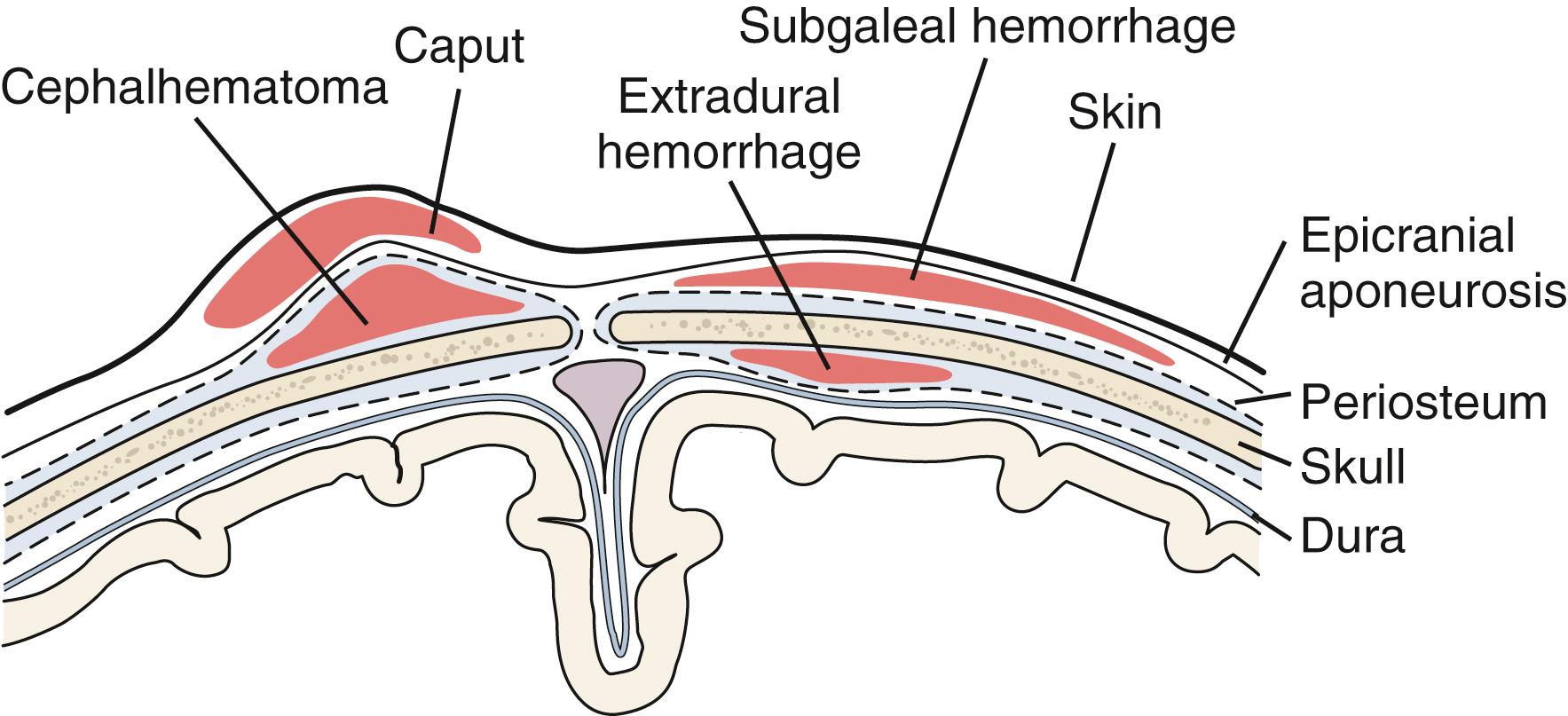
Often, confusion arises between the diagnosis of a caput and that of a cephalohematoma. The latter is a localized collection of blood beneath the periosteum of one of the calvarial bones; it may be bilateral, but it is most often unilateral ( Fig. 2.23 ). It is distinguished from a caput by the fact that the borders are limited by suture lines, usually those surrounding the parietal bones (see Fig. 2.22 ). However, diagnosis can be difficult in the immediate newborn period, when there may be overlying scalp edema. On palpation, the border may feel elevated and the center depressed. Most patients have an uncomplicated course of slow resolution over one or more months, although calcification may occur. On occasion, these infants may develop jaundice from the breakdown and resorption of the large hematoma. Underlying hairline skull fractures occur with some regularity but are rarely of clinical significance. The exception is the uncommon development of a leptomeningeal cyst. Radiologic investigation for an underlying depressed fracture is indicated in infants whose histories suggest significant trauma and those having depressed levels of consciousness or neurologic abnormalities on examination. Infection is another potentially serious but rare complication, which is more likely when the integrity of the overlying skin is broken, such as may occur when a scalp electrode is placed, or a scalp abrasion develops in the normal course of delivery.
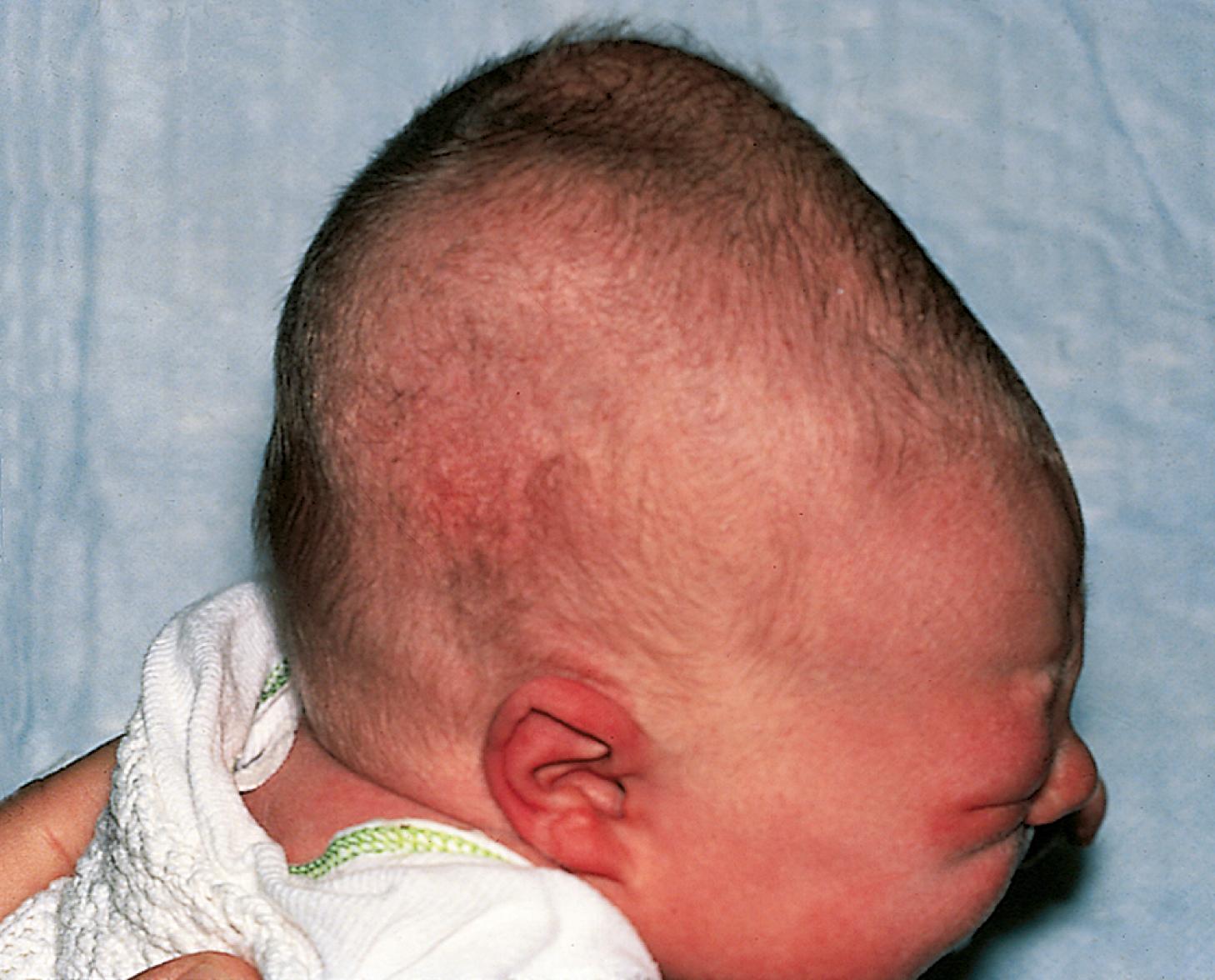
Fracture of a clavicle can occur during delivery when the infant is large, in breech position, or if there is fetal distress requiring rapid extraction. If nondisplaced, the fracture may not be painful, and the infant may be asymptomatic ( Fig. 2.24 ). The diagnosis may be suspected by palpation of crepitus, a lump over the clavicle, or an asymmetrical Moro reflex. If there is pain or discomfort with routine handling, the fracture can be treated by immobilization of the ipsilateral limb and shoulder with the elbow flexed 90 degrees. Immobilization can be discontinued when a callus is palpable at 8 to 10 days. Many nondisplaced clavicle fractures are not diagnosed until the first newborn outpatient follow-up visit, when a large, firm callus may be palpated along the clavicle. If the child has an otherwise normal physical and neurologic examination at this time, a radiograph is not indicated. Radiographs are indicated to differentiate whether decreased arm movement is secondary to pain (clavicle fracture) or nerve injury (Erb or Klumpke palsy).
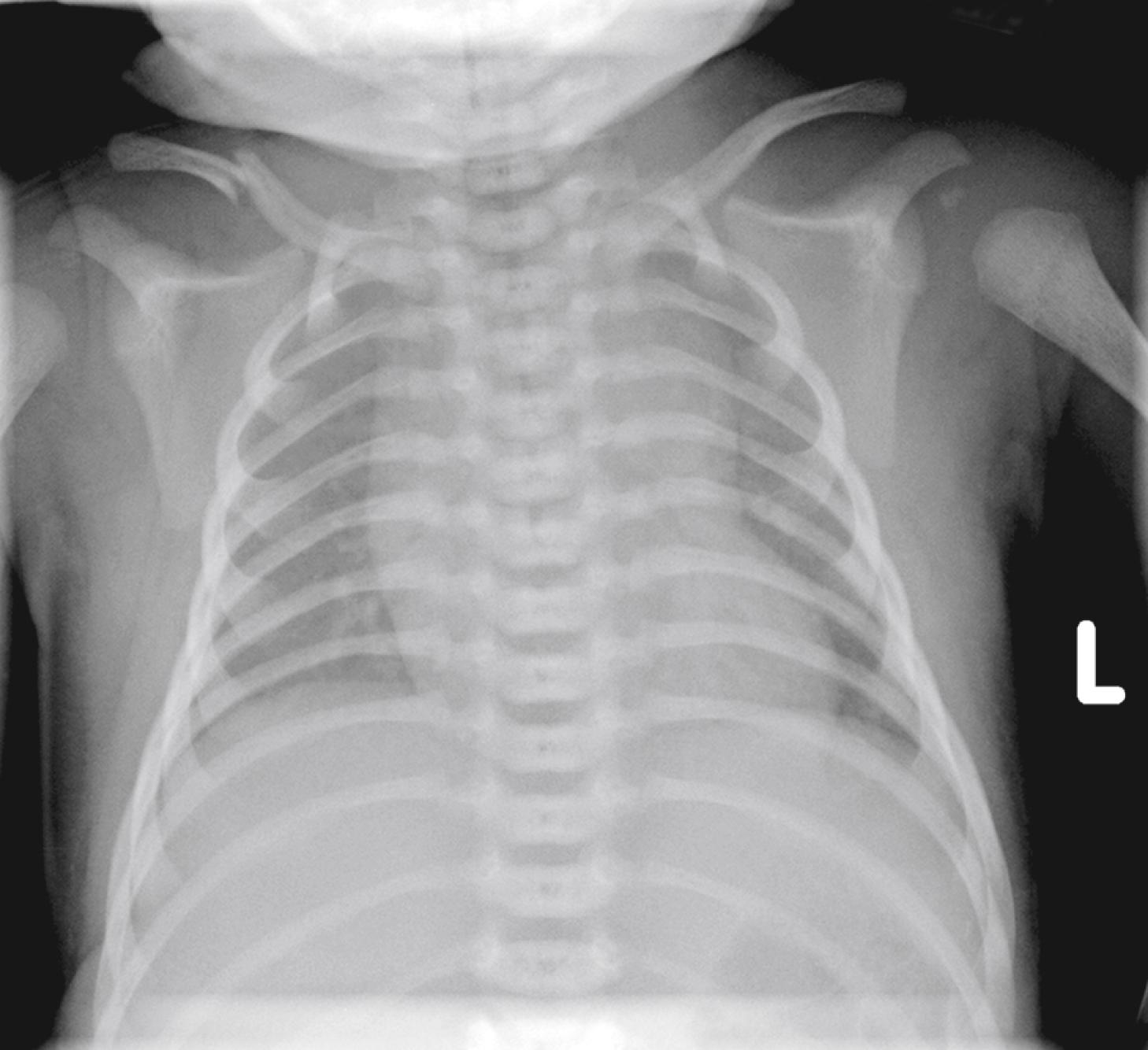
Superficial bruising can occur when delivery is difficult. This is relatively common with breech presentations and can include swelling and discoloration of the labia or scrotum (to be distinguished from an incarcerated inguinal hernia). When bruises are extensive, significant secondary jaundice may develop as the extravasated blood is broken down and resorbed. In an infant in whom a nuchal cord is found at delivery, the presence of diffuse petechiae around the head and neck is common and does not warrant further investigation. In addition, petechiae found on the presenting body part are normal. The appearance of new bruises or petechiae after delivery should alert the medical team to the possibility of a bleeding disorder or infection. Bruising and edema of the perineum can be normal when a newborn is delivered in a breech presentation. See “Scrotal Swelling” section in this chapter for special considerations of scrotal ecchymosis and swelling.
Many infants delivered with the aid of forceps show forceps marks after delivery. These marks tend to fade over 24 to 48 hours. On occasion, a well-circumscribed, firm nodule with purplish discoloration may appear at the site of a forceps mark. This may represent fat necrosis ( Fig. 2.25 ) and resolves spontaneously over weeks to months. The phenomenon may also occur at other sites of trauma. Affected infants may develop symptomatic hypercalcemia and serum calcium levels may need to be followed and treated.

Abnormalities of the nose are common after delivery, the majority consisting of transient flattening or twisting induced during transit through the birth canal. Less than 1% of nasal deformities are due to actual dislocations of the triangular cartilage of the nasal septum. These can be differentiated from positional deformities by manually moving the septum to the midline and observing the resultant shape of the nares. In a true dislocation, marked asymmetry of the nares persists ( Fig. 2.26 ). Returning the septum to its proper position can be accomplished in the nursery with the guidance of an otolaryngologist. Failure to recognize and treat dislocation may lead to permanent deformity.
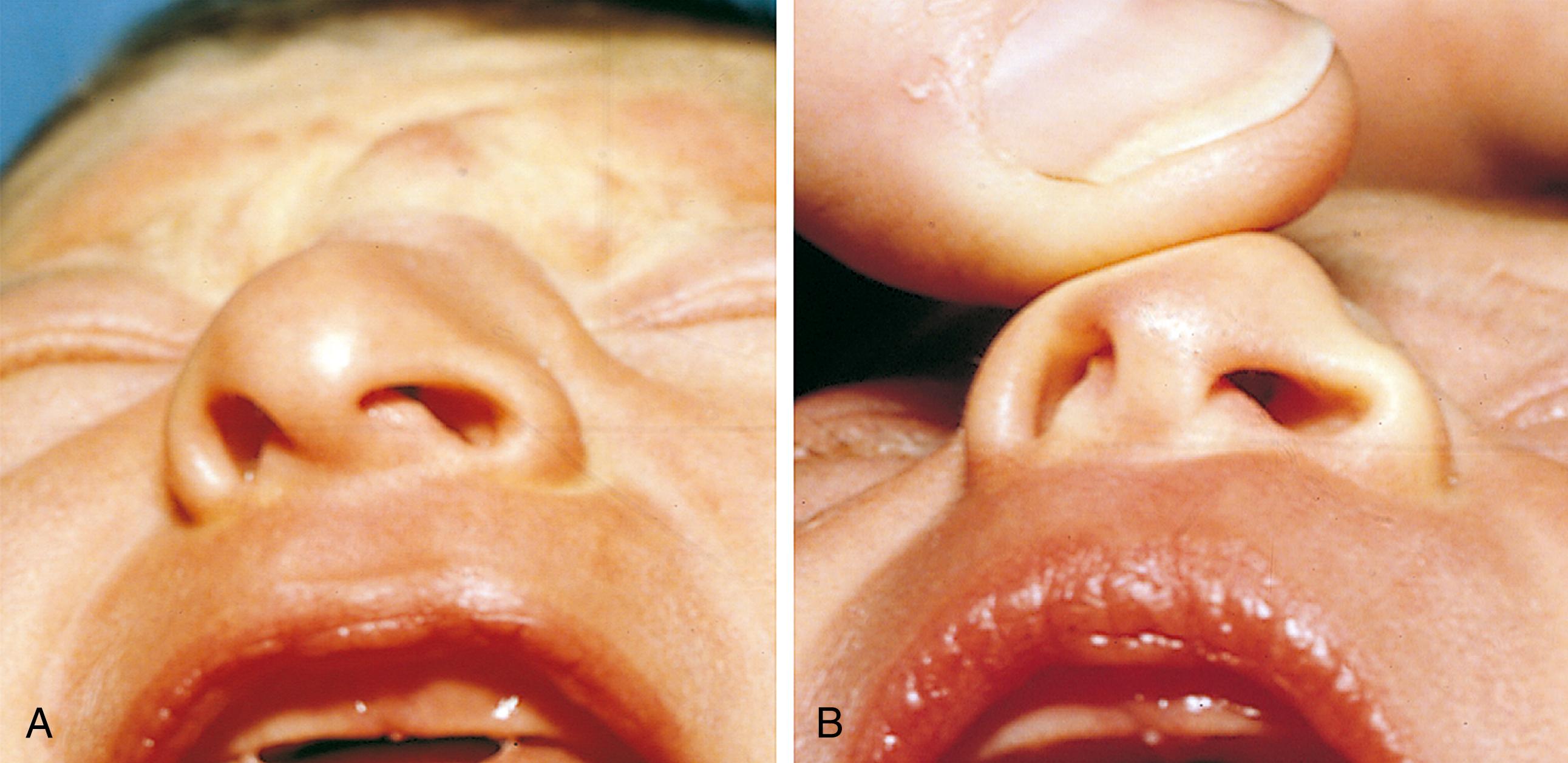
Injury to the peripheral nervous system, especially the facial and brachial nerves, is one of the more common serious occurrences related to birth. Unilateral facial nerve palsy is the most common peripheral nerve injury, with an incidence as high as 1.4 per 1000 live births. Injury can result from direct trauma from forceps or from compression of the nerve against the sacral promontory while the head is in the birth canal. With pronounced nerve injury, there is decreased facial movement and forehead wrinkling on the side of the palsy, eyelid elevation, and flattening of the nasolabial folds and corner of the mouth ( Fig. 2.27 ). Crying accentuates the findings, with the most obvious sign being asymmetrical movement of the mouth. The side that appears to droop when crying is the normal side. The differential diagnosis includes Möbius syndrome (usually bilateral) and absence of the depressor anguli oris muscle, which may be associated with cardiac anomalies. The latter condition is distinguishable from facial nerve palsy by the absence of involvement of the forehead, eyelid, or nasolabial area. The prognosis for facial nerve palsies is excellent, and recovery usually occurs within the first month. In the meantime, prevention of corneal drying is essential. Surgery is reserved for cases in which clear-cut severing of the facial nerve has occurred. Referral should be made if there is no improvement after 2 to 3 months.
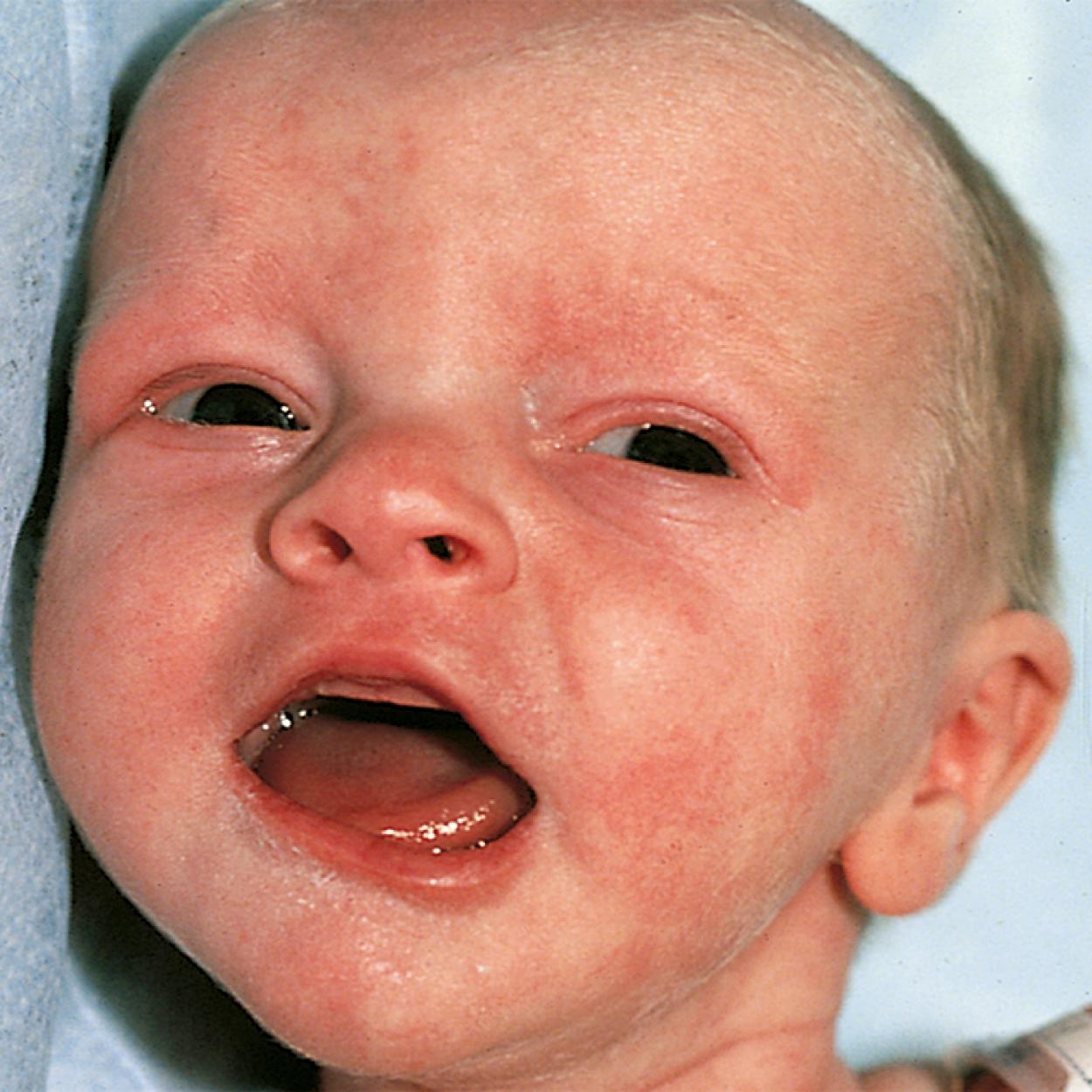
The incidence of brachial plexus trauma with current obstetric management is approximately 0.7 per 1000 live births. The mechanism of injury in most instances is traction on the plexus during delivery. Although lesions have classically been divided into those affecting upper spinal segments (Erb palsy) and those affecting lower segments (Klumpke palsy), the distinction may not be clear-cut in some cases. Injury to the C5 and C6 fibers is most often identified by the arm hanging limply adducted and internally rotated at the shoulder, extended and pronated at the elbow ( Fig. 2.28A ). Injury affecting the lower segments of C7 and T1 rarely occurs in isolation, causing weakness of the wrist and hand, and ultimately leads to a claw-hand deformity ( Fig. 2.28B and C ). There may be sensory loss along the ulnar side of the hand and forearm in the distribution of the T1 dermatome. If the T1 root is affected with interruption of the sympathetic innervation at that level, Horner syndrome (constricted pupil, drooping upper eyelid, and local inability to sweat on one side of the face) may be apparent. Appropriate deep-tendon reflexes are absent. It may be difficult to confirm a sensory deficit, and autonomic fibers are often intact. Diagnosis is made clinically, but electromyography may be indicated to assess the severity of the injury and to determine the prognosis in patients not showing improvement after 6 to 8 weeks. Treatment should be deferred for at least 7 to 10 days; then specific physical therapy and splinting should be undertaken. Most infants with brachial plexus palsies demonstrate complete recovery in the first few months of life. Earlier recovery suggests better long-term prognosis.
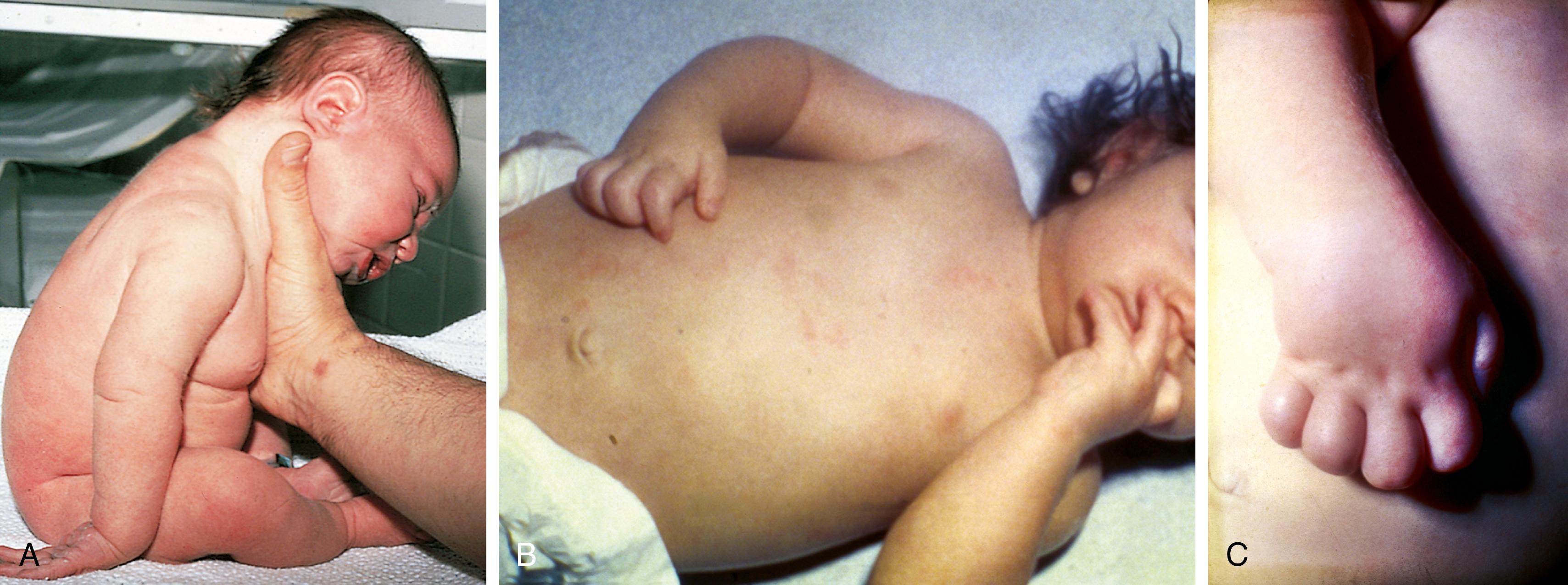
Innumerable congenital anomalies, many of a minor nature, can be noted at birth. Although any single minor malformation may be of little medical consequence, the identification of three or more in a single infant may be a clue to more serious errors of morphogenesis. A careful family history including examination of the parents and siblings can often place these malformations in proper perspective.
Become a Clinical Tree membership for Full access and enjoy Unlimited articles
If you are a member. Log in here